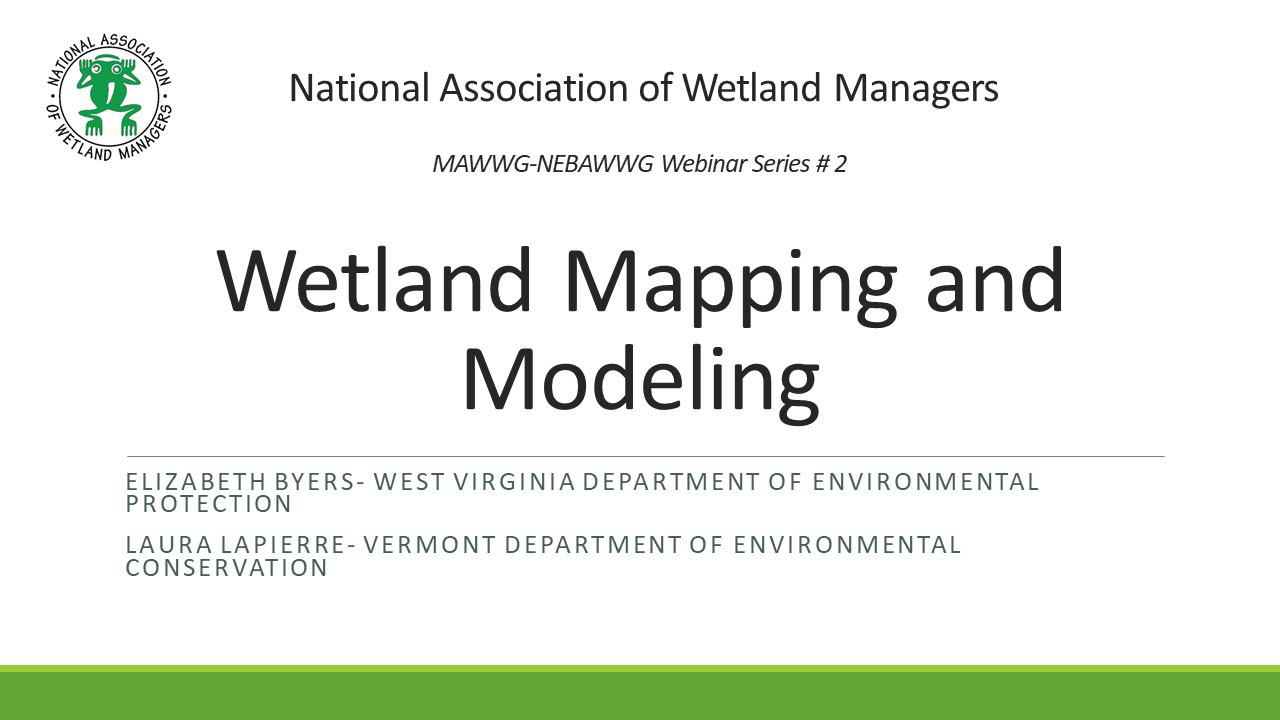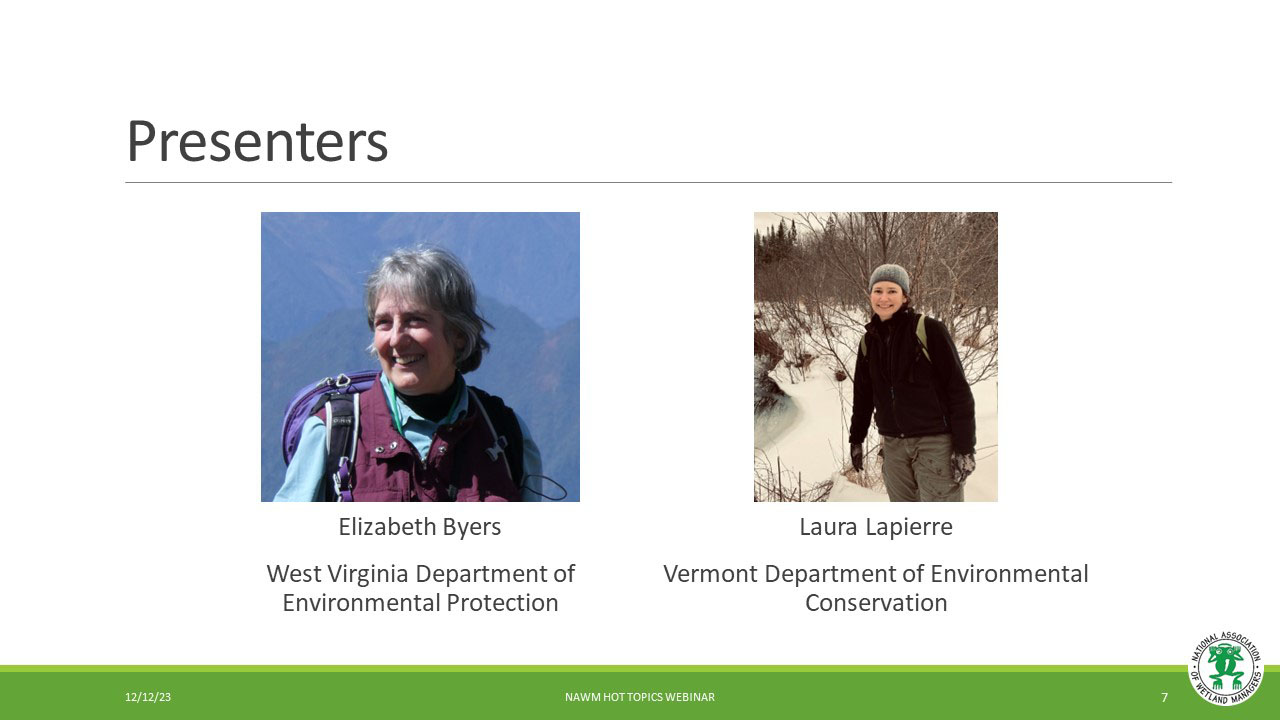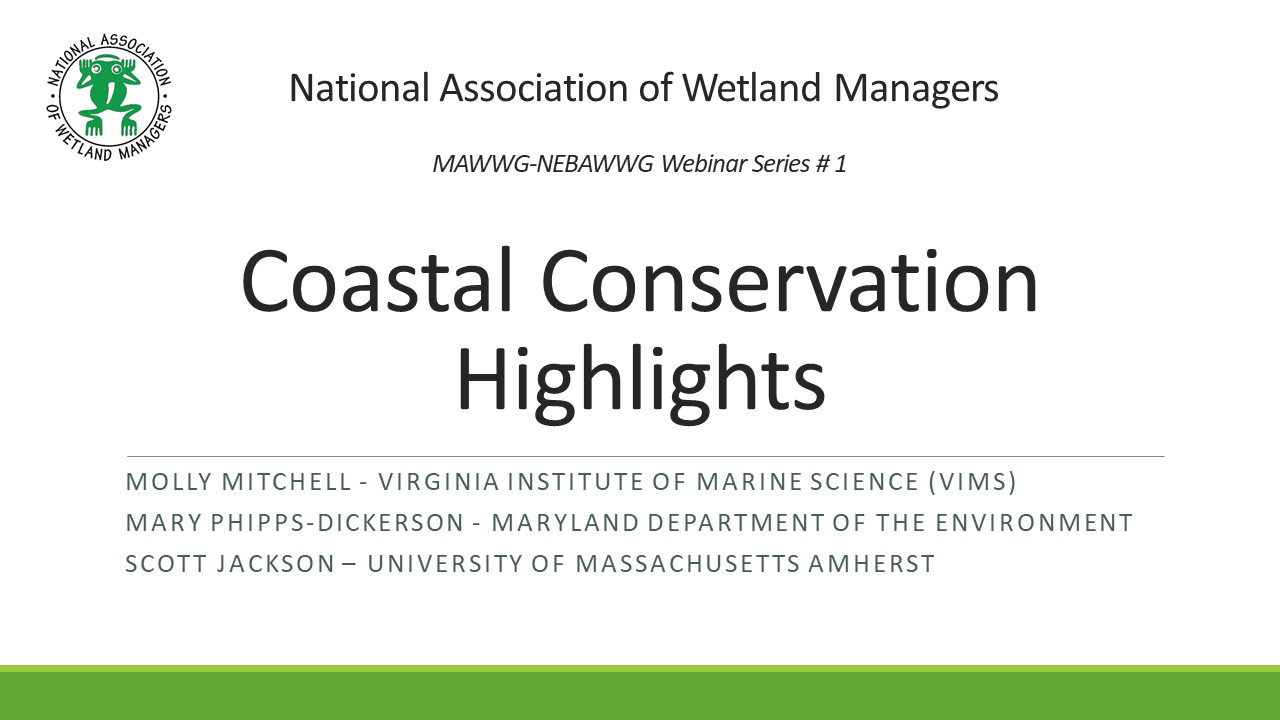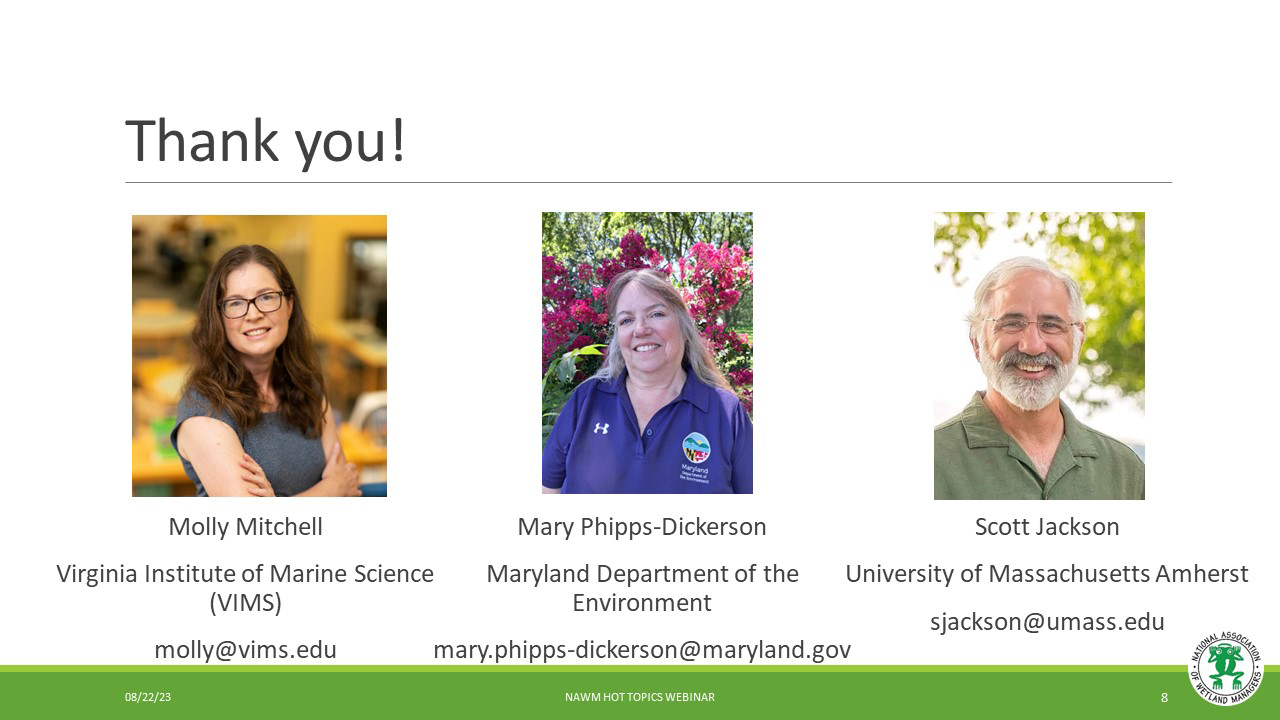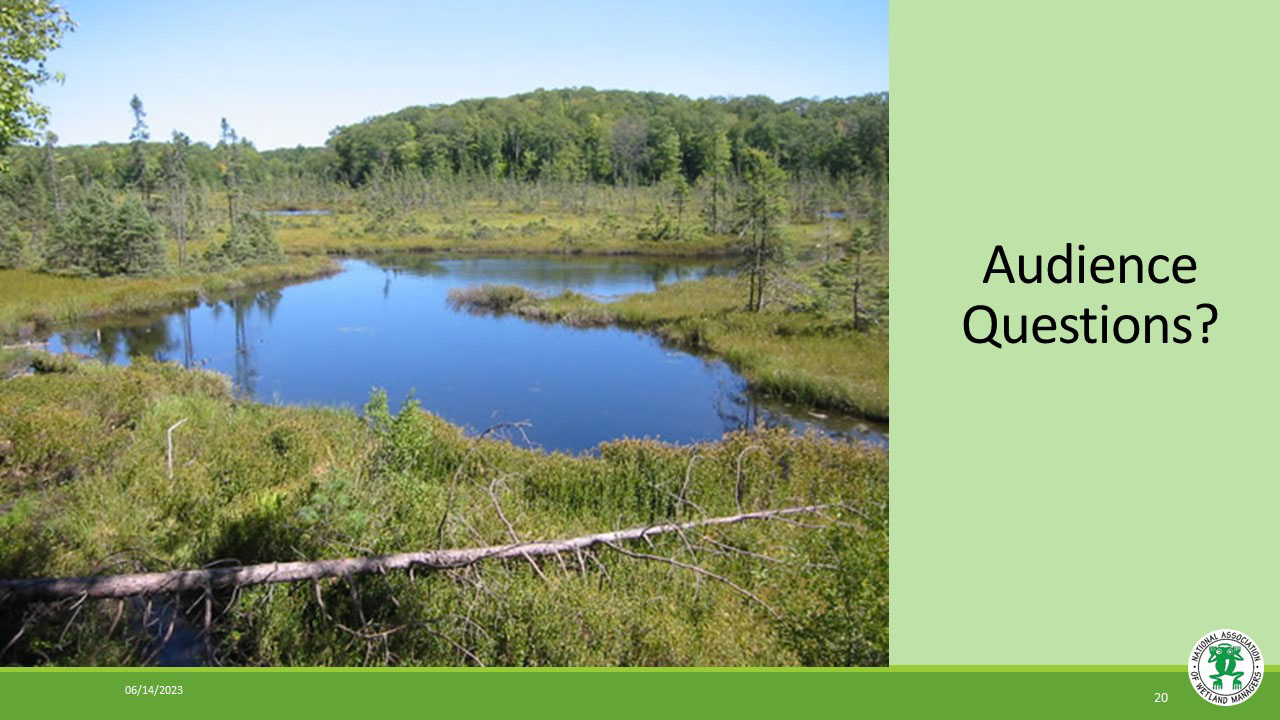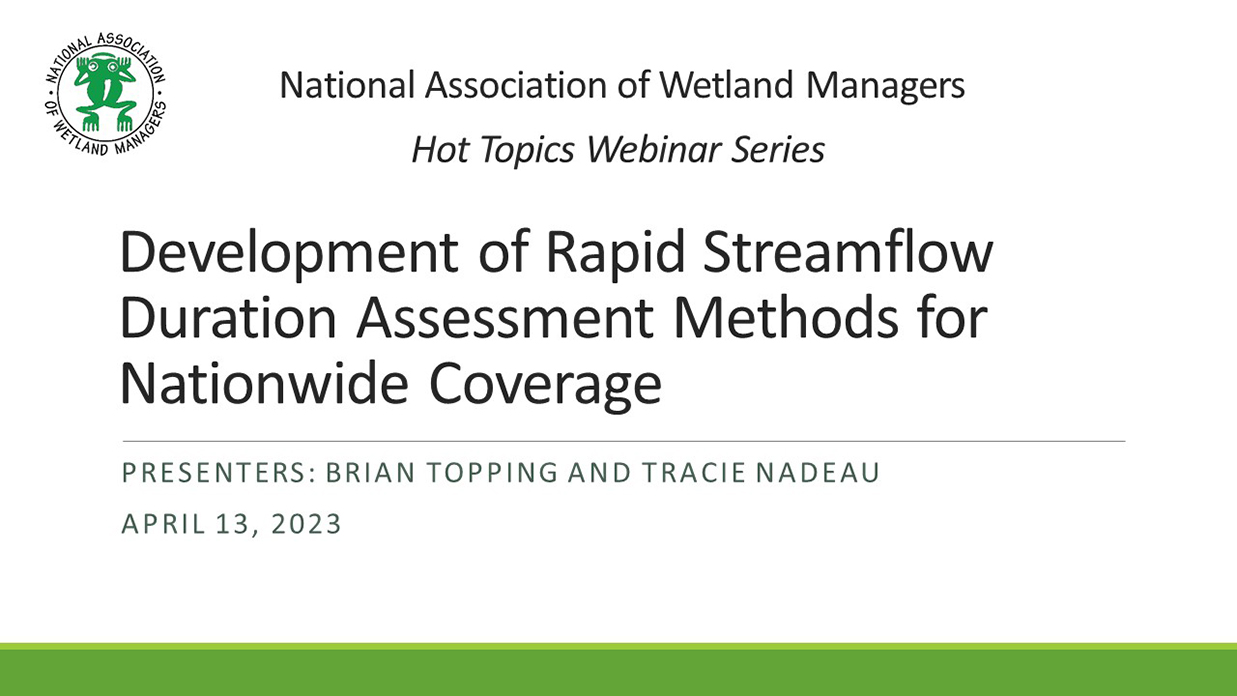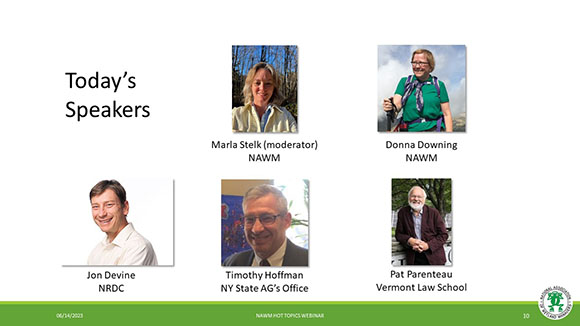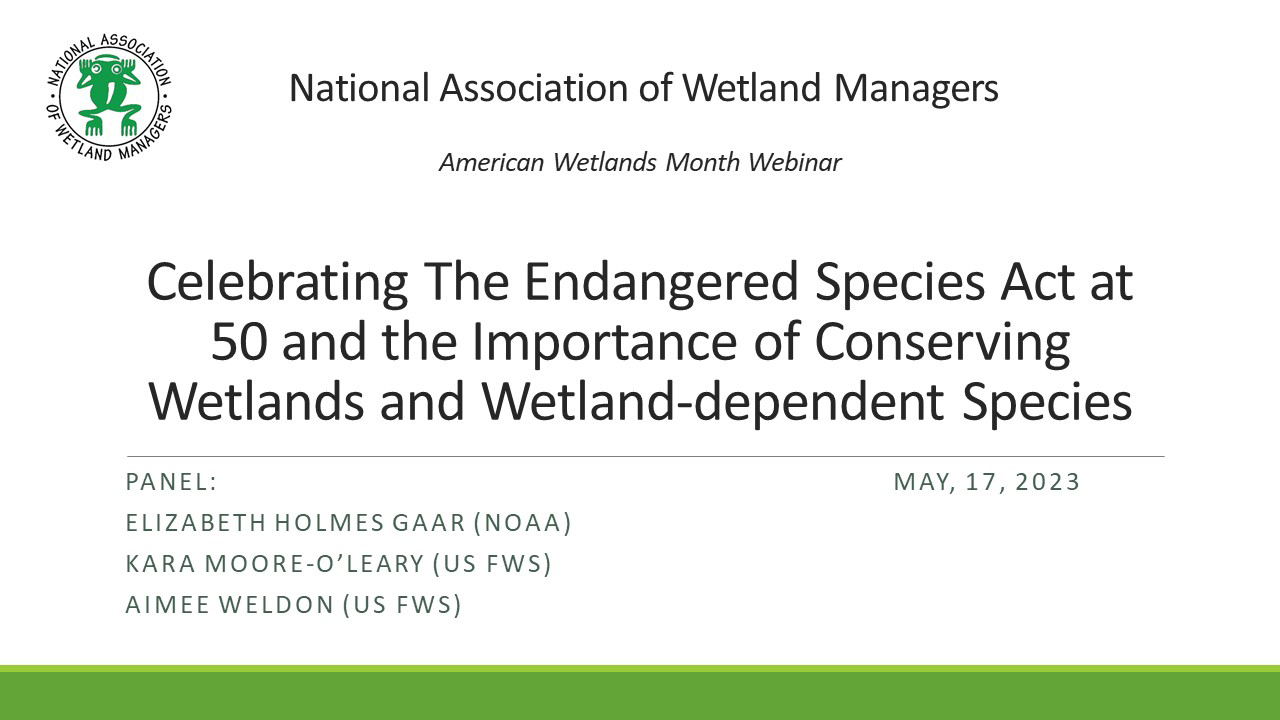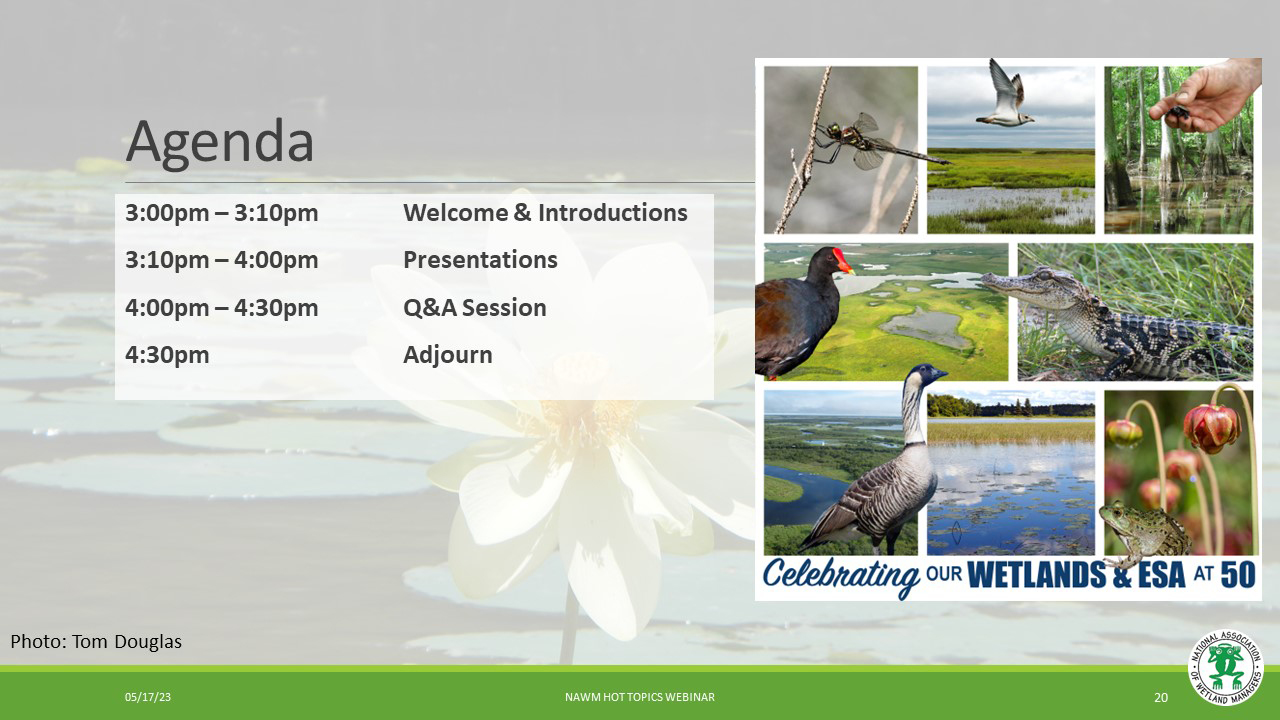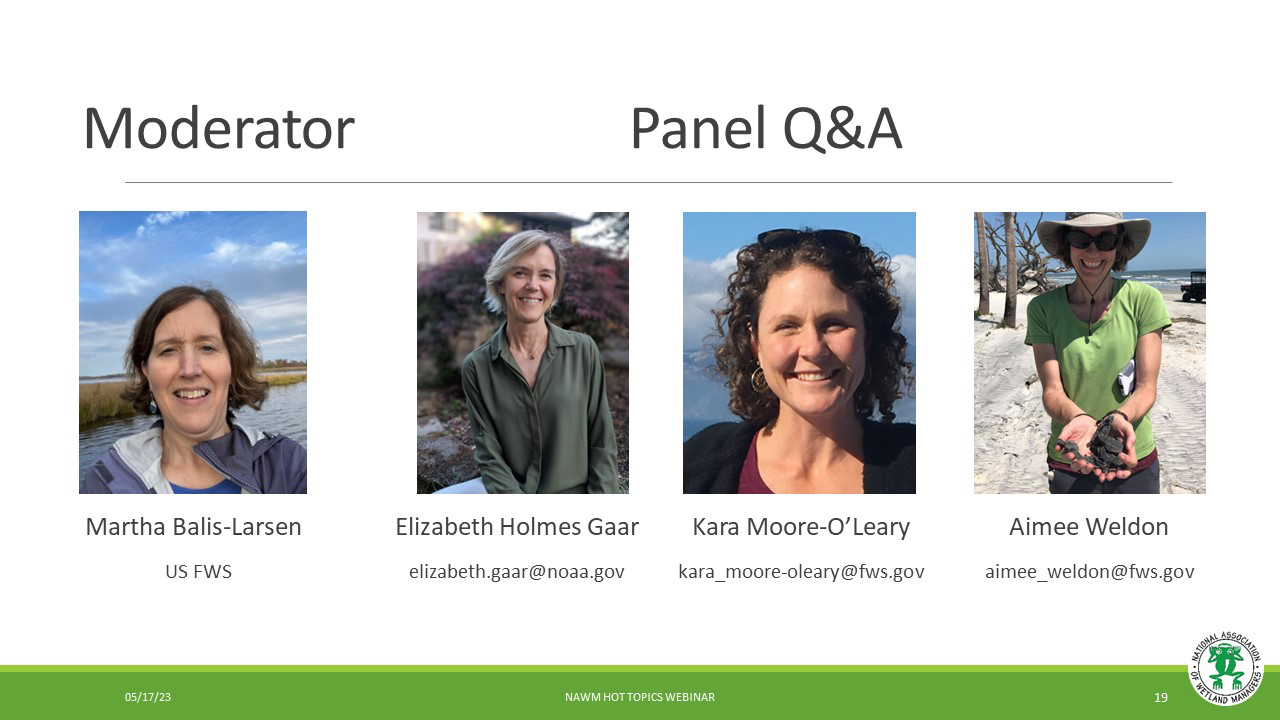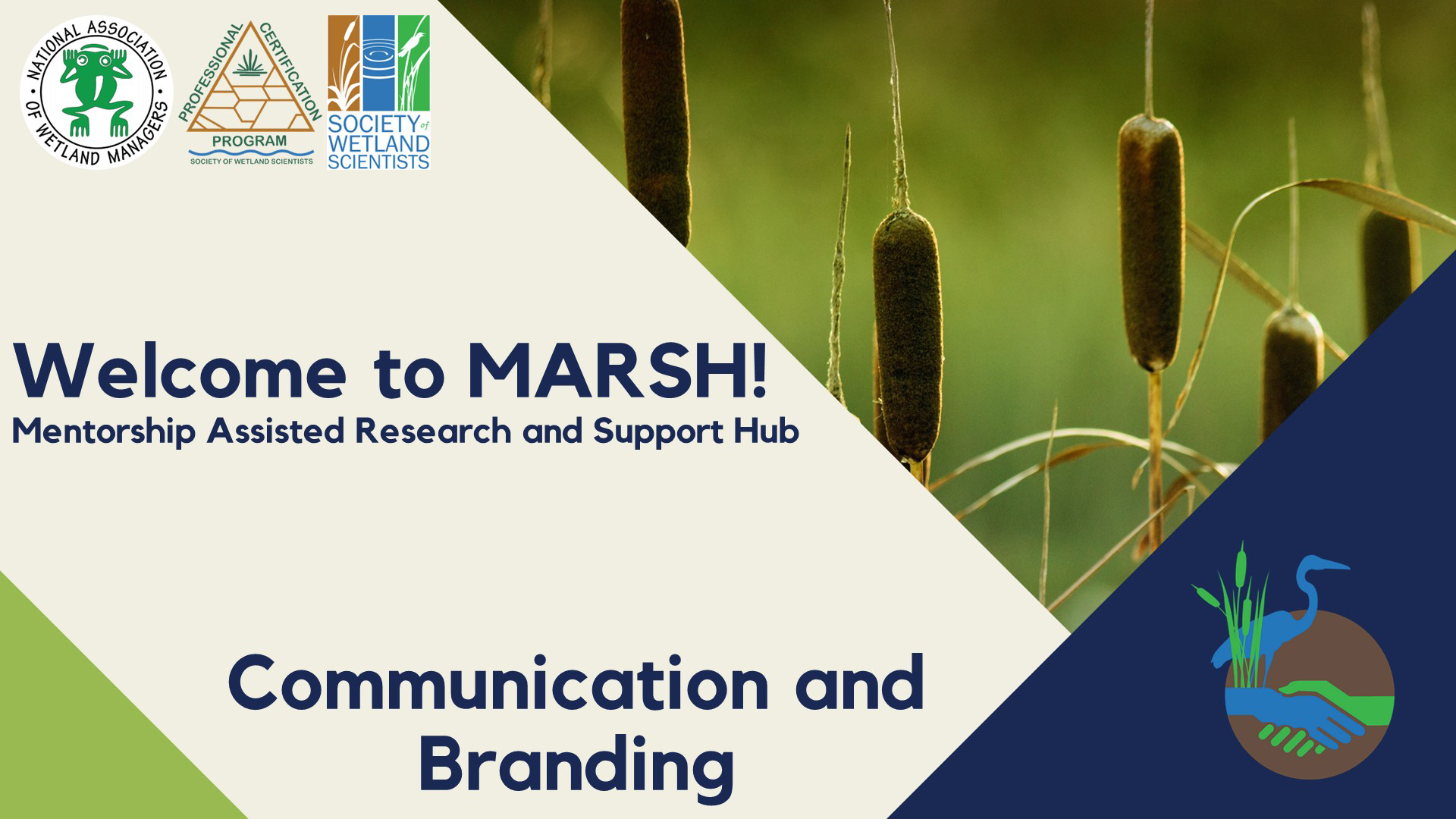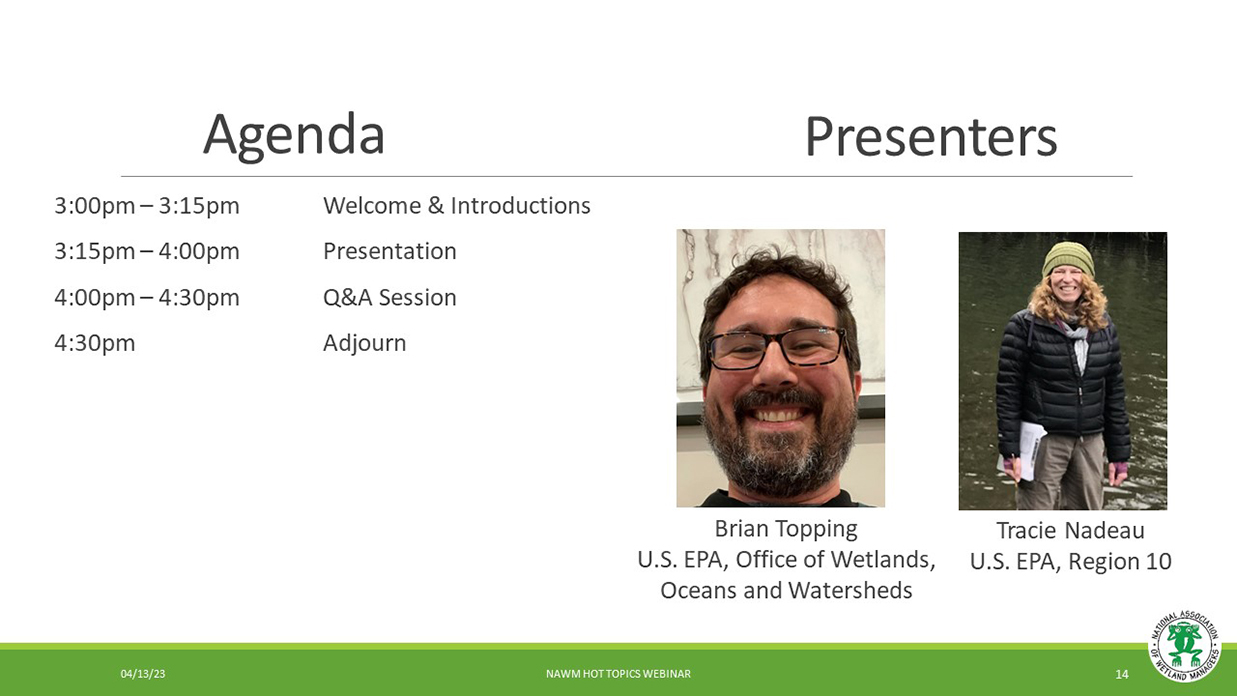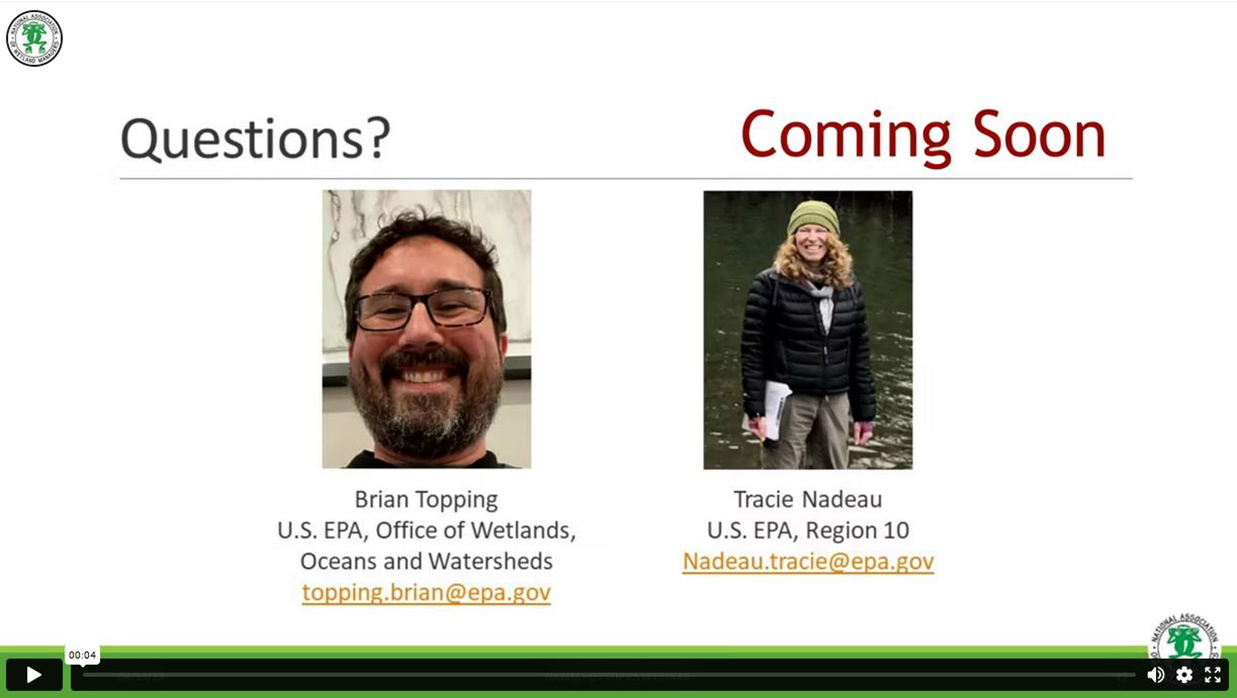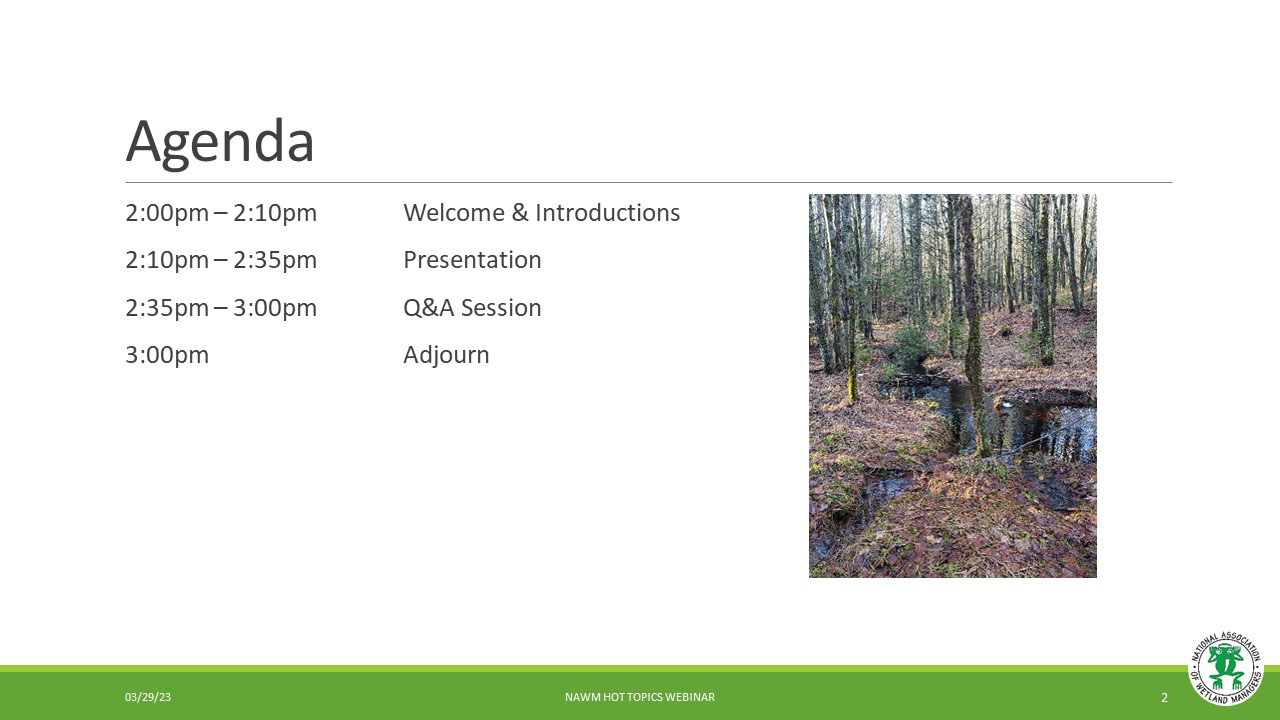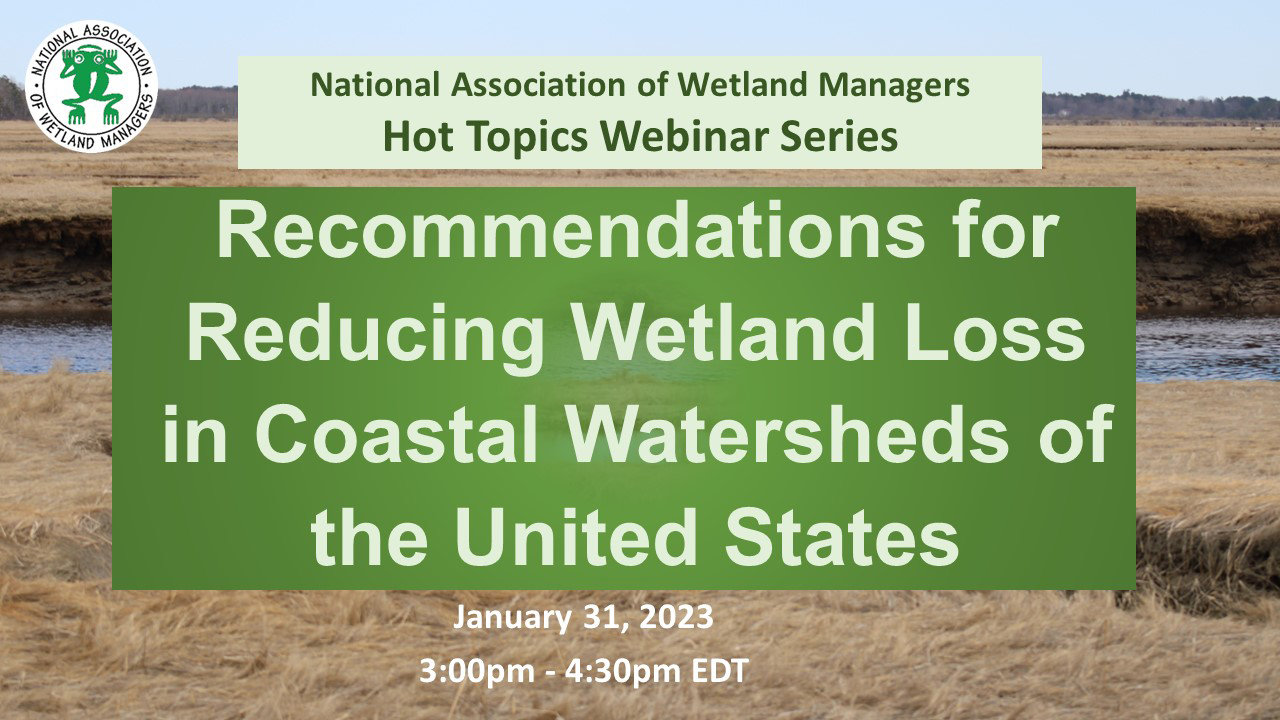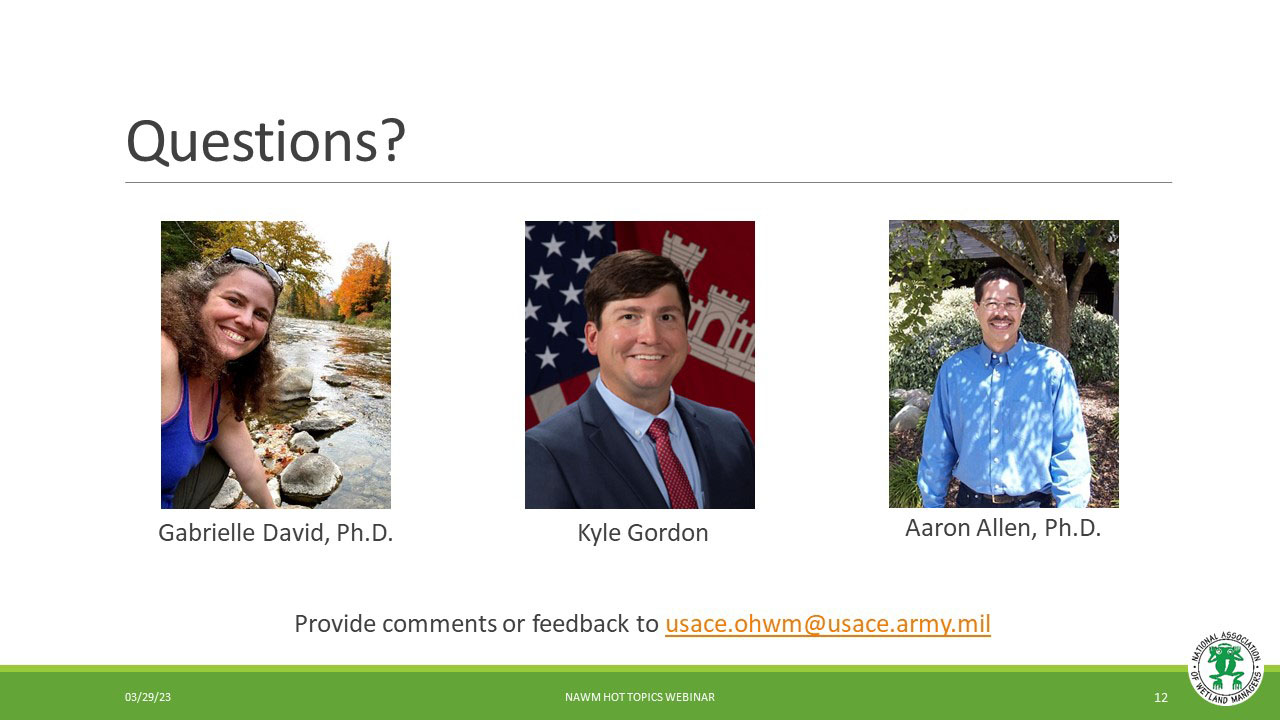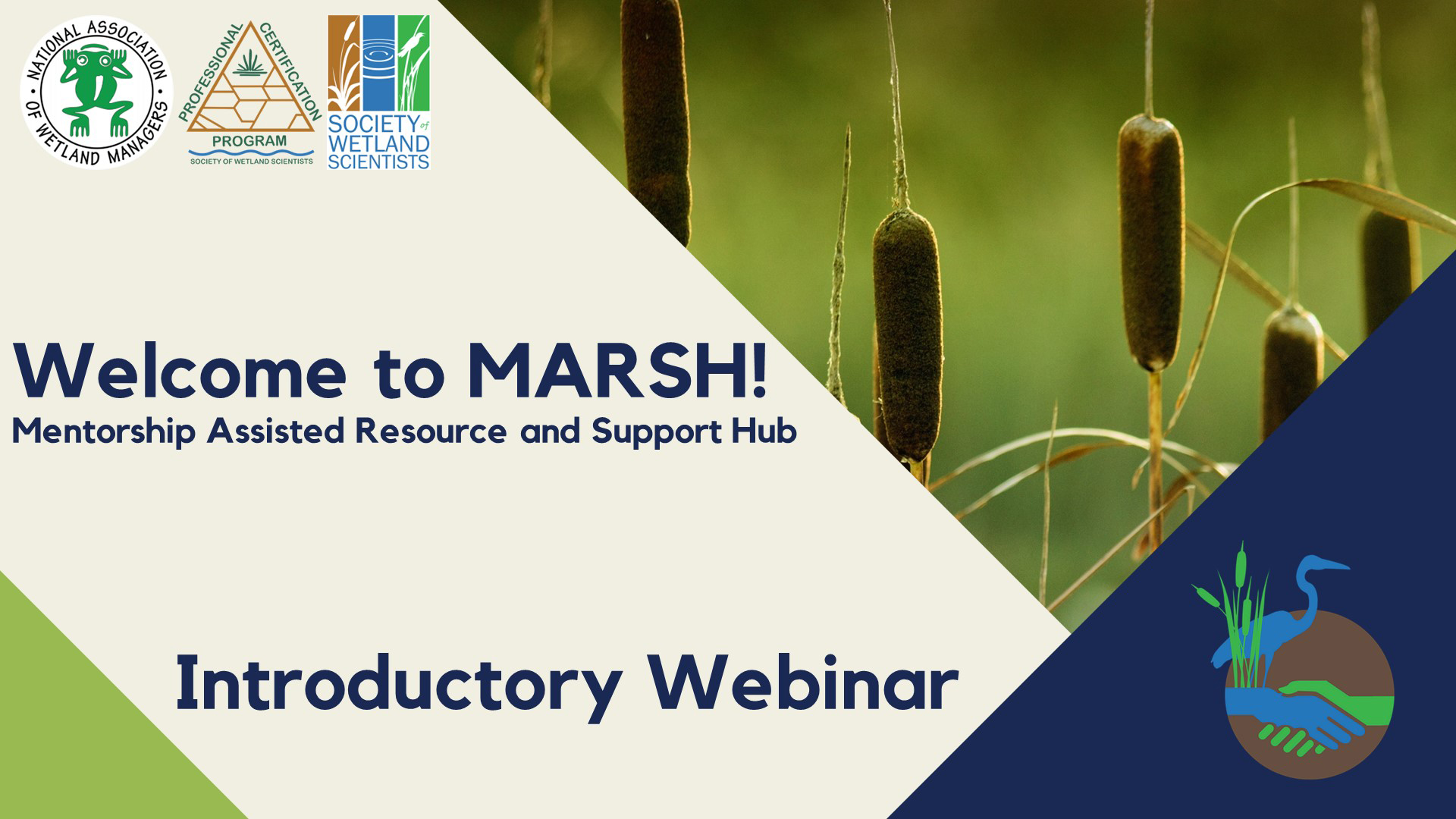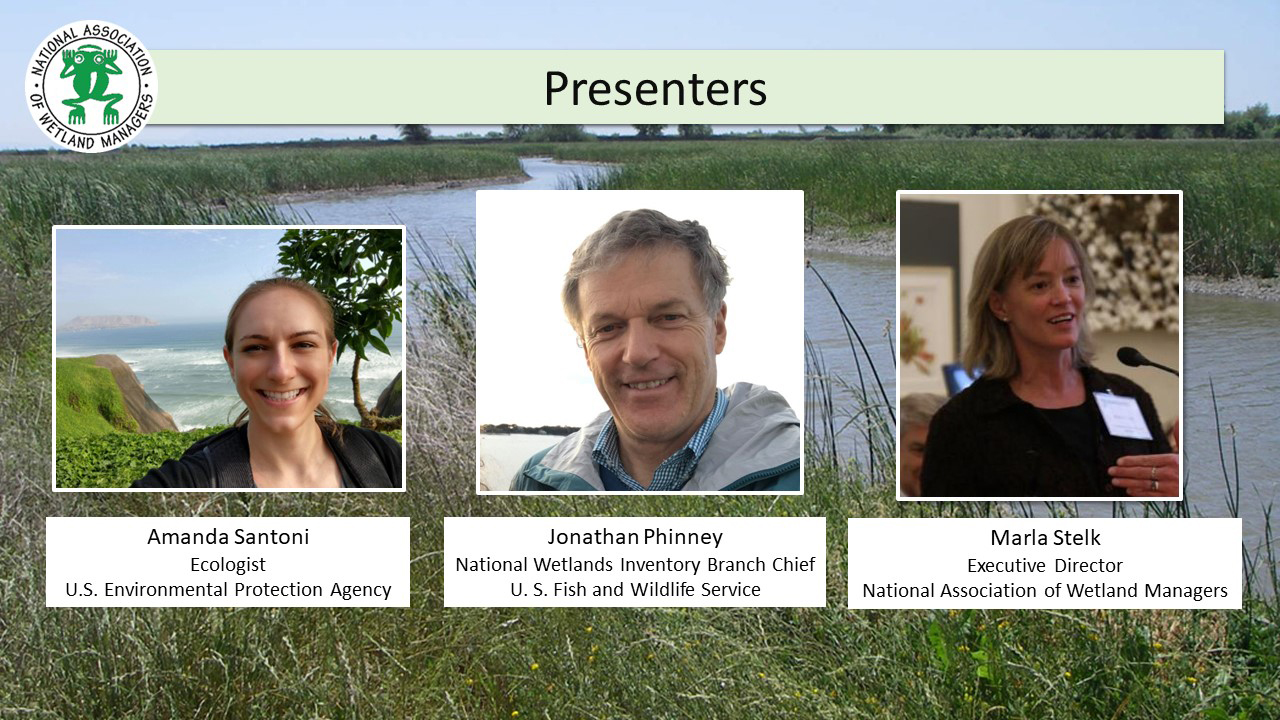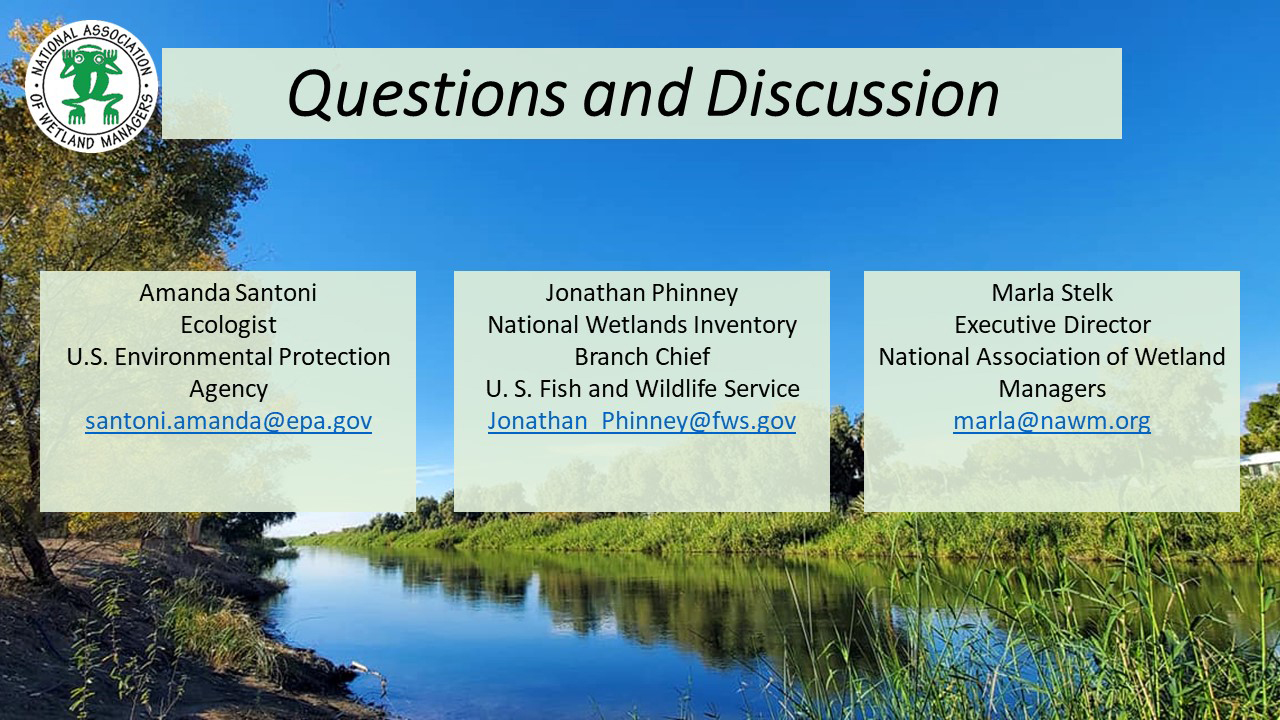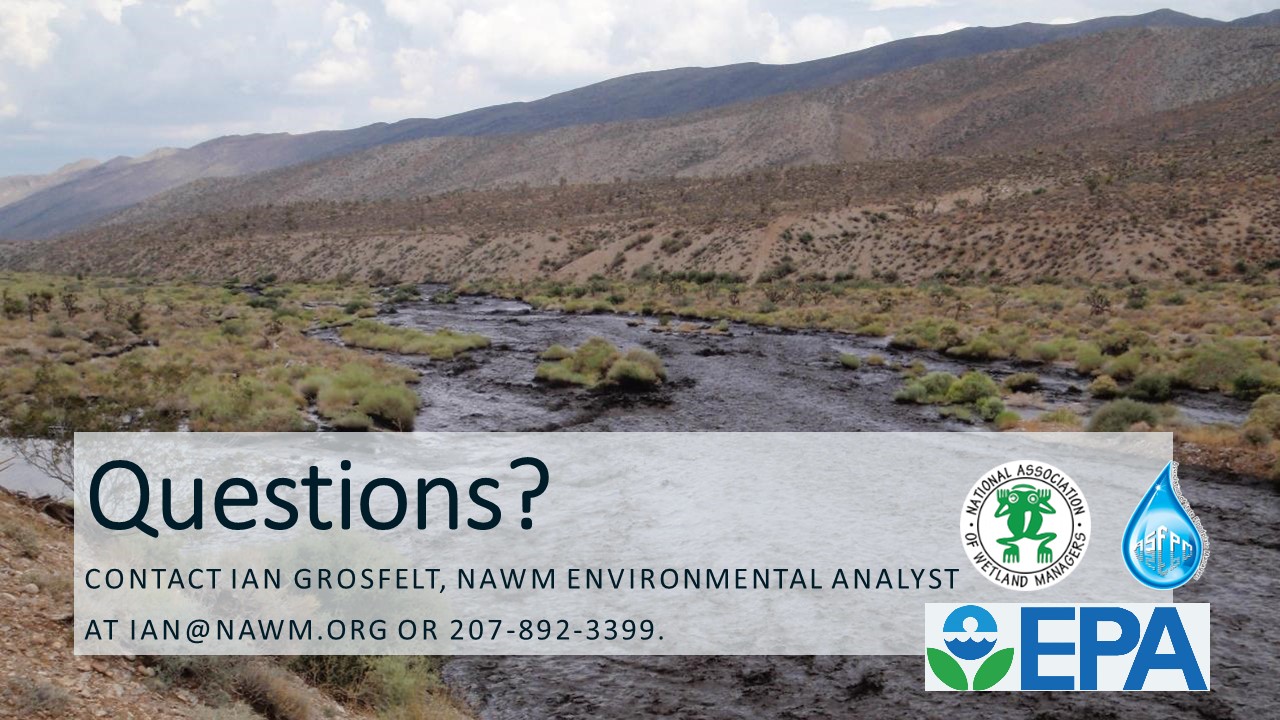2023 MAWWG-NEBAWWG Webinar Series #2: Wetland Mapping, Modeling, and Assessing
Held Tuesday, December 12, 2023 - 3:00-4:00 p.m. ET
This is part 2 of a three-part webinar series highlighting EPA Wetland Program Development Grant grantees in regions 1-3.
This second webinar will focus on geospatial mapping and analysis wetlands.
INTRODUCTION
- Ian Grosfelt, National Association of Wetland Managers [PRESENTATION PDF]
PRESENTERS
- Elizabeth Byers, West Virginia Department of Environmental Protection [PRESENTATION PDF]
- Laura Lapierre, Vermont Department of Environmental Conservation [PRESENTATION PDF]
BIOS
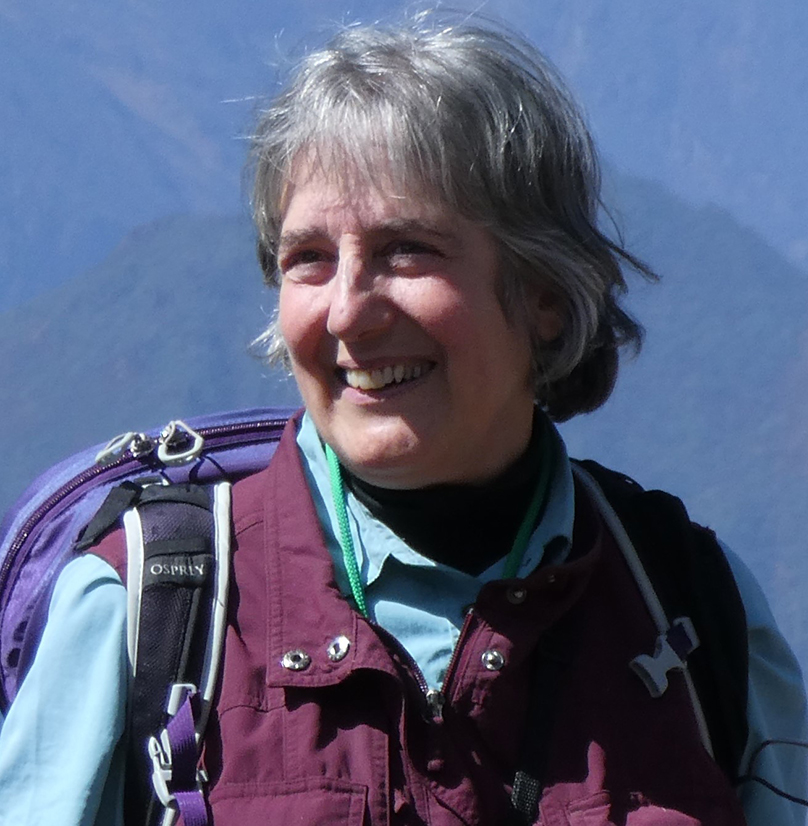 Elizabeth Byers is a Senior Wetland Scientist with the West Virginia Department of Environmental Protection. She has led the design and implementation of a combined field and GIS protocol for wetland functional assessment and wetland condition monitoring, which will be formalized as part of Clean Water Act enforcement in West Virginia in January 2024.
Elizabeth Byers is a Senior Wetland Scientist with the West Virginia Department of Environmental Protection. She has led the design and implementation of a combined field and GIS protocol for wetland functional assessment and wetland condition monitoring, which will be formalized as part of Clean Water Act enforcement in West Virginia in January 2024.
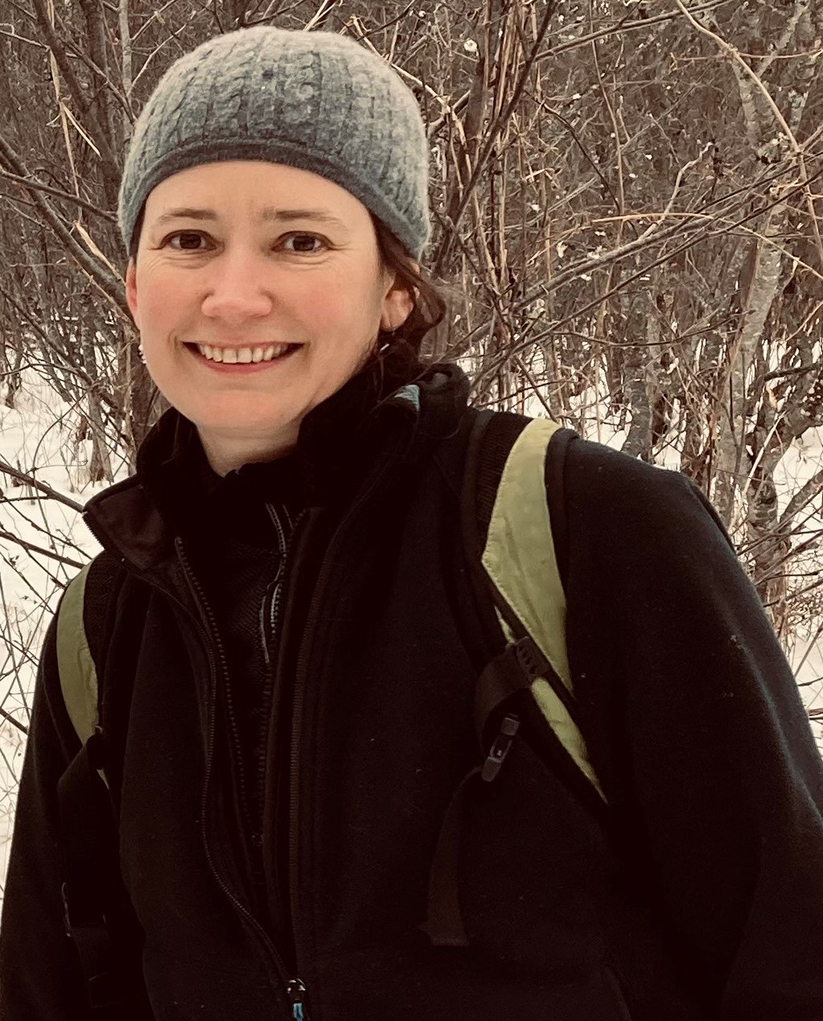 Laura Lapierre is the Program Manager for the Vermont Department of Environmental Conservation’s Wetlands Program. The VT Wetlands Program administers the Vermont Wetland Rules, assesses the State's wetland health, maps wetlands, and assists voluntary restoration. In Laura’s 9 years managing the program, she and her team have received funding from the EPA Region 1 Wetland Program Development Grants. Laura has a Master's in biology from McGill University.
Laura Lapierre is the Program Manager for the Vermont Department of Environmental Conservation’s Wetlands Program. The VT Wetlands Program administers the Vermont Wetland Rules, assesses the State's wetland health, maps wetlands, and assists voluntary restoration. In Laura’s 9 years managing the program, she and her team have received funding from the EPA Region 1 Wetland Program Development Grants. Laura has a Master's in biology from McGill University.
Please click only once on each video recording to view in this window.

2023 MAWWG-NEBAWWG Webinar Series
#1 Coastal Conservation Highlights
Held Tuesday, August 22, 2023 - 3:00-4:30 p.m. ET
This is part 1 of a three-part webinar series highlighting EPA Wetland Program Development Grant projects in regions 1-3. The first webinar focused on the conservation of coastal wetlands.
INTRODUCTION
- Ian Grosfelt, National Association of Wetland Managers [PRESENTATION PDF]
PRESENTERS/ABSTRACTS
Mary Phipps-Dickerson, Maryland Department of the Environment [PRESENTATION PDF]
Use of Unoccupied Aerial Systems (UA) to Assess Salt Marsh Vulnerability to Sea Level Rise
Scott Jackson, University of Massachusetts Amherst [PRESENTATION PDF]
Field work in salt marshes is difficult because tide cycles affect our ability to access interior portions of marshes and to see/evaluate marsh characteristics due to ever changing water levels. Remote sensing (satellite imagery; aerial photographs) offer some potential for assessing salt marsh characteristics. However, these data may not be available at stages in the tide cycle when specific characteristics need to be assessed, such as high tide for assessing high marsh flooding or low tide for assessing creek bank stability. We are investigating using Unoccupied Aerial Systems (drones and sensors) to collect data when timing is critical and evaluate the use of various sensors to create detailed maps salt marsh site (vegetation, bare ground, water features, elevation) and assess vegetation health/stress and physical characteristics of salt marshes. Using arrays of water loggers and detailed digital terrain models developed from UAS data, we will characterize the hydrology of salt marshes and correlate marsh vegetation with tidal hydrology. We are also using machine learning and object identification techniques to identify eroding creek channels within salt marsh, with an aim to create a bank erosion metric that can be applied statewide using readily available aerial photography.
Strategies for Coastal Wetland Conservation Prioritization in Virginia Under Climate Change
Molly Mitchell, Virginia Institute of Marine Science [PRESENTATION PDF]
Accelerating sea level rise brings new considerations into coastal wetland conservation efforts. This project focuses on developing strategies to improve our understanding and strengthen the sustainability of Virginia’s coastal wetlands climate change. Marsh migration under sea level rise is a primary pathway for marsh persistence. However, the rate at which migration occurs and the resulting extent and habitat function of the newly migrated marsh is dependent on factors including location and its nexus to developed lands. Prioritizing conservation actions requires the ability to monitor change in both wetland extent and its habitat provision. We are developing remote monitoring protocols of coastal wetland vegetation that will help us understand where changes are occurring. We are also monitoring marsh bird usage to understand how changing extents and vegetation impact the habitat provision of our coastal wetlands.
BIOS
 Mary Phipps-Dickerson is a Natural Resources Planner with the Tidal Wetlands Division of the Maryland Department of the Environment. She reviews and authorizes projects proposed by communities, municipalities and private property owners to conduct work in, on, over, or under tidal wetlands ranging from shoreline stabilization efforts through marsh restoration, marsh enhancement, thin layer placement, reef balls and breakwaters, as well as navigational projects including dredging, pier, and marina projects. Review criteria take sea level rise, subsidence, and coastal resiliency into consideration while balancing wetland impacts and resource conversions. Mary is currently reviewing the Mid-Chesapeake Bay Island Ecosystem Restoration Project which includes the restoration of Barren Island and James Island and incorporates the beneficial reuse of dredged material.
Mary Phipps-Dickerson is a Natural Resources Planner with the Tidal Wetlands Division of the Maryland Department of the Environment. She reviews and authorizes projects proposed by communities, municipalities and private property owners to conduct work in, on, over, or under tidal wetlands ranging from shoreline stabilization efforts through marsh restoration, marsh enhancement, thin layer placement, reef balls and breakwaters, as well as navigational projects including dredging, pier, and marina projects. Review criteria take sea level rise, subsidence, and coastal resiliency into consideration while balancing wetland impacts and resource conversions. Mary is currently reviewing the Mid-Chesapeake Bay Island Ecosystem Restoration Project which includes the restoration of Barren Island and James Island and incorporates the beneficial reuse of dredged material.
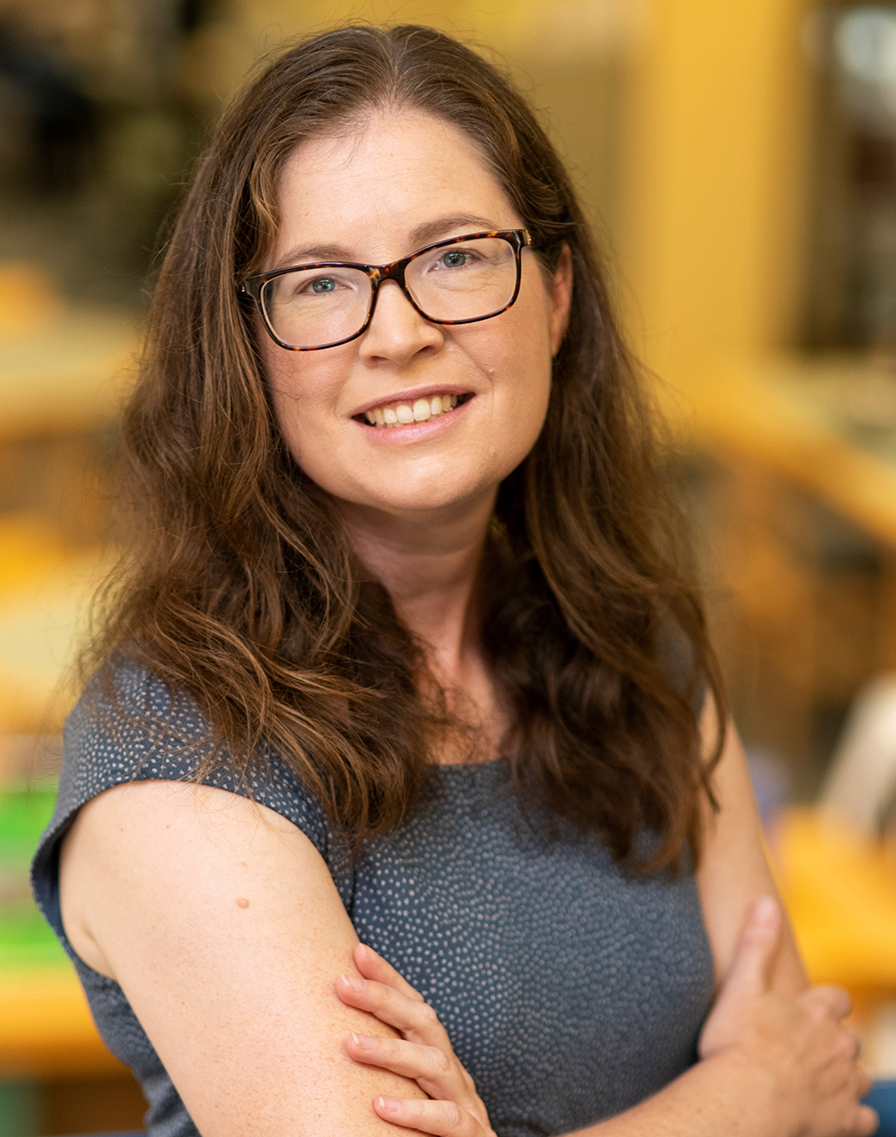 Dr. Molly Mitchell is a Research Assistant Professor and Director of the Professional MA program at the Virginia Institute of Marine Science (VIMS). Her research focuses on shifts in coastal resources due to the interaction of sea level rise and human-driven changes; a topic at the intersection of multiple disciplines, including projects involving ecology (marsh changes and blue carbon), physical dynamics (sea level rise trend analysis, shoreline geology) and human decision making (social vulnerability, sea level rise adaptation, adaptive management application). She works with representatives from many different groups to help translate research and current scientific understanding into practical recommendations. Dr. Mitchell was awarded a 2019 US CLIVAR Early Career Leadership Awards for her climate change communication efforts and is the co-lead for the World Climate Research Program' Safe Landing Lighthouse Activity’s Sea Level Rise Working Group.
Dr. Molly Mitchell is a Research Assistant Professor and Director of the Professional MA program at the Virginia Institute of Marine Science (VIMS). Her research focuses on shifts in coastal resources due to the interaction of sea level rise and human-driven changes; a topic at the intersection of multiple disciplines, including projects involving ecology (marsh changes and blue carbon), physical dynamics (sea level rise trend analysis, shoreline geology) and human decision making (social vulnerability, sea level rise adaptation, adaptive management application). She works with representatives from many different groups to help translate research and current scientific understanding into practical recommendations. Dr. Mitchell was awarded a 2019 US CLIVAR Early Career Leadership Awards for her climate change communication efforts and is the co-lead for the World Climate Research Program' Safe Landing Lighthouse Activity’s Sea Level Rise Working Group.
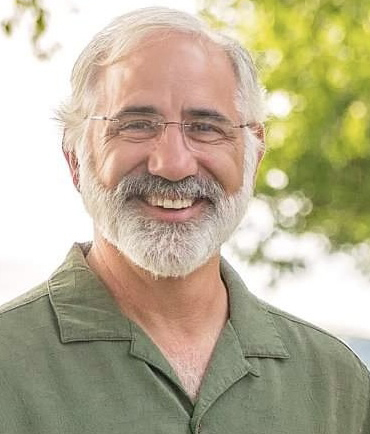 Scott Jackson is Extension Professor in the Department of Environmental Conservation at the University of Massachusetts Amherst where he teaches courses on wetlands and wildlife conservation and management. Scott’s research interests include aquatic connectivity, wetland assessment and monitoring, impacts of roads and highways on wildlife and ecosystems, and landscape-based ecological assessment. Scott has been involved in the development of standards for road-stream crossing structures, survey protocols for assessing crossing structures for aquatic and terrestrial passability, and approaches for prioritizing road-stream crossing structures for replacement. He coordinates the North Atlantic Aquatic Connectivity Collaborative (NAACC), a network of practitioners in the 13-state North Atlantic region working to enhance river and stream connectivity. As a member of the UMass Landscape Ecology Lab, Scott contributed to the development of landscape assessment tools and approaches including the Conservation Assessment and Prioritization System (CAPS), Designing Sustainable Landscapes (DSL) and Critical Linkages.
Scott Jackson is Extension Professor in the Department of Environmental Conservation at the University of Massachusetts Amherst where he teaches courses on wetlands and wildlife conservation and management. Scott’s research interests include aquatic connectivity, wetland assessment and monitoring, impacts of roads and highways on wildlife and ecosystems, and landscape-based ecological assessment. Scott has been involved in the development of standards for road-stream crossing structures, survey protocols for assessing crossing structures for aquatic and terrestrial passability, and approaches for prioritizing road-stream crossing structures for replacement. He coordinates the North Atlantic Aquatic Connectivity Collaborative (NAACC), a network of practitioners in the 13-state North Atlantic region working to enhance river and stream connectivity. As a member of the UMass Landscape Ecology Lab, Scott contributed to the development of landscape assessment tools and approaches including the Conservation Assessment and Prioritization System (CAPS), Designing Sustainable Landscapes (DSL) and Critical Linkages.
Please click only once on each video recording to view in this window.
![]() Implications of the Supreme Court’s Sackett Decision for Protection of Wetlands and Waters
Implications of the Supreme Court’s Sackett Decision for Protection of Wetlands and Waters
Held Wednesday, June 14, 2023 - 3:00 p.m. - 4:30 p.m. EDT
INTRODUCTION
- Marla Stelk, Executive Director, National Association of Wetland Managers [PRESENTATIONS PDF]
PRESENTERS
- Jon Devine, Director, Federal Water Policy, Natural Resources Defense Council (NRDC)
- Donna Downing, Senior Legal Policy Advisor, National Association of Wetland Managers (NAWM), former Jurisdiction Team Leader in EPA’s Office of Water (1998-2020)
- Timothy Hoffman, Senior Counsel, New York State Attorney General
- Pat Parenteau, Professor of Law Emeritus, Vermont Law School
ABSTRACT
On May 25, 2023, the U.S. Supreme Court announced its decision in Sackett v. EPA. The majority opinion establishes Justice Scalia’s “relatively permanent” analysis as the standard for determining when a wetland, stream, or other water is a “water of the United States” (WOTUS) protected by the federal Clean Water Act (CWA). This webinar provided an overview of the decision and some of the ambiguities it contains, discuss the decision’s potential impacts on aquatic resource protection, and explore some of the potential next steps for states and tribes.
BIOS
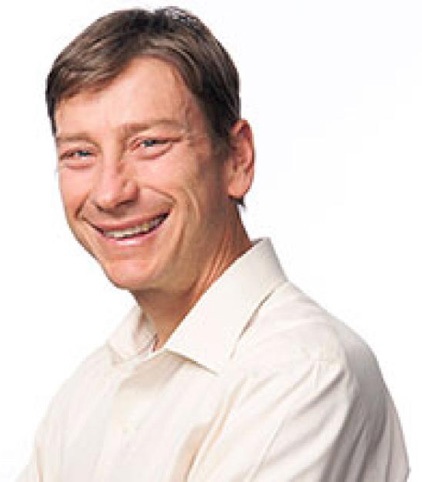 Jon Devine leads NRDC’s federal water policy team. His work focuses on implementing, defending, and strengthening the core programs under the Clean Water Act. Prior to working on water policy, he worked with NRDC’s Health & Environment program for four years. Previously, he served as an attorney-adviser in the U.S. Environmental Protection Agency’s Office of General Counsel and also worked as an environmental specialist in Maine’s Department of Environmental Protection. Devine graduated from Bowdoin College and received his JD from Georgetown University. He is based in NRDC’s Washington, D.C., office.
Jon Devine leads NRDC’s federal water policy team. His work focuses on implementing, defending, and strengthening the core programs under the Clean Water Act. Prior to working on water policy, he worked with NRDC’s Health & Environment program for four years. Previously, he served as an attorney-adviser in the U.S. Environmental Protection Agency’s Office of General Counsel and also worked as an environmental specialist in Maine’s Department of Environmental Protection. Devine graduated from Bowdoin College and received his JD from Georgetown University. He is based in NRDC’s Washington, D.C., office.
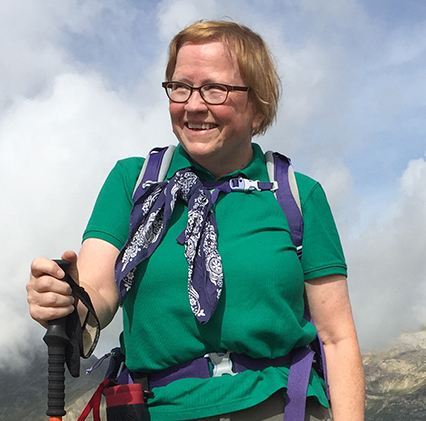 Donna Downing is the Senior Legal Policy Advisor at the National Association of Wetland Managers. Donna was the Jurisdiction Team Leader in the U.S. Environmental Protection Agency’s (EPA) Office of Wetlands, Oceans, and Watersheds from 2007-2020. Donna worked on a variety of issues at EPA, with a focus in recent years on the geographic scope of the Clean Water Act (CWA) in light of the U.S. Supreme Court decisions. She also served as EPA’s staff lead for CWA section 401 water quality certification, and on wetland-related legal issues. Prior to joining EPA in 1998, Donna worked for the U.S. Congress Office of Technology Assessment and in private law practice. She has a BA magna cum laude from Harvard University, an MPP from the University of California at Berkeley, a JD cum laude from Georgetown University Law School, and an LLM in Environmental Law summa cum laude from George Washington University Law School. Donna has been an adjunct professor at George Washington University Law School since 1996, teaching environmental law. In what’s left of her time, she moonlights as a professional potter and an unprofessional horse trainer. Donna also enjoys traveling and has traveled by reindeer sled in the Swedish Arctic, gone winter camping with dog sleds in Minnesota’s Boundary Waters Wilderness Area, and bicycled the Burma Road in China.
Donna Downing is the Senior Legal Policy Advisor at the National Association of Wetland Managers. Donna was the Jurisdiction Team Leader in the U.S. Environmental Protection Agency’s (EPA) Office of Wetlands, Oceans, and Watersheds from 2007-2020. Donna worked on a variety of issues at EPA, with a focus in recent years on the geographic scope of the Clean Water Act (CWA) in light of the U.S. Supreme Court decisions. She also served as EPA’s staff lead for CWA section 401 water quality certification, and on wetland-related legal issues. Prior to joining EPA in 1998, Donna worked for the U.S. Congress Office of Technology Assessment and in private law practice. She has a BA magna cum laude from Harvard University, an MPP from the University of California at Berkeley, a JD cum laude from Georgetown University Law School, and an LLM in Environmental Law summa cum laude from George Washington University Law School. Donna has been an adjunct professor at George Washington University Law School since 1996, teaching environmental law. In what’s left of her time, she moonlights as a professional potter and an unprofessional horse trainer. Donna also enjoys traveling and has traveled by reindeer sled in the Swedish Arctic, gone winter camping with dog sleds in Minnesota’s Boundary Waters Wilderness Area, and bicycled the Burma Road in China.
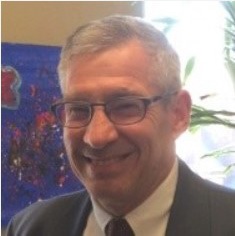 Timothy Hoffman is the Senior Counsel for the New York State Attorney General. He is responsible for cases against industrial polluters and multi-state litigation against the federal government. Represent New York in a wide variety of environmental matters in federal and state trial and appellate courts. Serve as lead counsel in complex cases involving water and air pollution, natural resources, hazardous substances, nuclear waste, energy law, federal rollback of environmental protections, and environmental impact review. Multi-state litigation efforts include representing six Great Lakes states in Northwest Environmental Advocates v. EPA, 537 F.3d 1006 (9th Cir. 2008), where the Ninth Circuit invalidated EPA's regulatory exemption of vessel-discharged aquatic invasive species from Clean Water Act pollution controls. In 2015 achieved one of the largest groundwater impact settlements in New York history, responding to the collapse and flooding of North America's largest salt mine, the former Akzo-Nobel Salt Mine located in western New York. Previously served as a trial attorney in the Manhattan District Attorney's Office prosecuting violent crimes. Clerked for the late U.S. District Court Judge William Ingram in the Northern District of California. Worked as a staff analyst for the Wisconsin Legislature's joint committee overseeing executive agency regulatory authority. Graduate of the University of Wisconsin Law School and Indiana University, with honors and distinction from the School of Public and Environmental Affairs. Admitted to practice law in the State of New York, the U.S. District Court for the Southern, Eastern and Western Districts of New York, and the U.S. Court of Appeals for the Second, Sixth and Ninth Circuits.
Timothy Hoffman is the Senior Counsel for the New York State Attorney General. He is responsible for cases against industrial polluters and multi-state litigation against the federal government. Represent New York in a wide variety of environmental matters in federal and state trial and appellate courts. Serve as lead counsel in complex cases involving water and air pollution, natural resources, hazardous substances, nuclear waste, energy law, federal rollback of environmental protections, and environmental impact review. Multi-state litigation efforts include representing six Great Lakes states in Northwest Environmental Advocates v. EPA, 537 F.3d 1006 (9th Cir. 2008), where the Ninth Circuit invalidated EPA's regulatory exemption of vessel-discharged aquatic invasive species from Clean Water Act pollution controls. In 2015 achieved one of the largest groundwater impact settlements in New York history, responding to the collapse and flooding of North America's largest salt mine, the former Akzo-Nobel Salt Mine located in western New York. Previously served as a trial attorney in the Manhattan District Attorney's Office prosecuting violent crimes. Clerked for the late U.S. District Court Judge William Ingram in the Northern District of California. Worked as a staff analyst for the Wisconsin Legislature's joint committee overseeing executive agency regulatory authority. Graduate of the University of Wisconsin Law School and Indiana University, with honors and distinction from the School of Public and Environmental Affairs. Admitted to practice law in the State of New York, the U.S. District Court for the Southern, Eastern and Western Districts of New York, and the U.S. Court of Appeals for the Second, Sixth and Ninth Circuits.
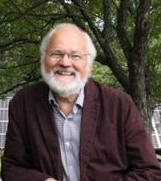 Pat Parenteau is Professor of Law and Senior Counsel in the Environmental Advocacy Clinic at Vermont Law School. He previously served as Director of the Environmental Law Center and was the founding director of the EAC (formerly the Environmental and Natural Resources Law Clinic) in 2004. Professor Parenteau has an extensive background in environmental and natural resources law. His previous positions include Vice President for Conservation with the National Wildlife Federation in Washington, DC (1976- 1984); Regional Counsel to the New England Regional Office of the EPA in Boston (1984-1987); Commissioner of the Vermont Department of Environmental Conservation (1987-1989); and Senior Counsel with the Perkins Coie law firm in Portland, Oregon (1989-1993). Professor Parenteau has been involved in drafting, litigating, implementing, teaching, and writing about environmental law and policy for over three decades. His current focus is on confronting the profound challenges of climate change through his teaching, publishing, public speaking and litigation. Professor Parenteau is a Fulbright US Scholar and a Fellow in the American College of Environmental Lawyers. In 2005 he received the National Wildlife Federation’s Conservation Achievement Award in recognition of his contributions to wildlife conservation and environmental education. In 2016 he received the Kerry Rydberg Award for excellence in public interest environmental law. Professor Parenteau holds a B.S. from Regis University, a J.D. from Creighton University, and an LLM in Environmental Law from the George Washington University Law School.
Pat Parenteau is Professor of Law and Senior Counsel in the Environmental Advocacy Clinic at Vermont Law School. He previously served as Director of the Environmental Law Center and was the founding director of the EAC (formerly the Environmental and Natural Resources Law Clinic) in 2004. Professor Parenteau has an extensive background in environmental and natural resources law. His previous positions include Vice President for Conservation with the National Wildlife Federation in Washington, DC (1976- 1984); Regional Counsel to the New England Regional Office of the EPA in Boston (1984-1987); Commissioner of the Vermont Department of Environmental Conservation (1987-1989); and Senior Counsel with the Perkins Coie law firm in Portland, Oregon (1989-1993). Professor Parenteau has been involved in drafting, litigating, implementing, teaching, and writing about environmental law and policy for over three decades. His current focus is on confronting the profound challenges of climate change through his teaching, publishing, public speaking and litigation. Professor Parenteau is a Fulbright US Scholar and a Fellow in the American College of Environmental Lawyers. In 2005 he received the National Wildlife Federation’s Conservation Achievement Award in recognition of his contributions to wildlife conservation and environmental education. In 2016 he received the Kerry Rydberg Award for excellence in public interest environmental law. Professor Parenteau holds a B.S. from Regis University, a J.D. from Creighton University, and an LLM in Environmental Law from the George Washington University Law School.
Please click only once on each video recording to view in this window.
![]()
Celebrating the Endangered Species Act at 50 and the Importance of Conserving Wetlands and Wetland-dependent Species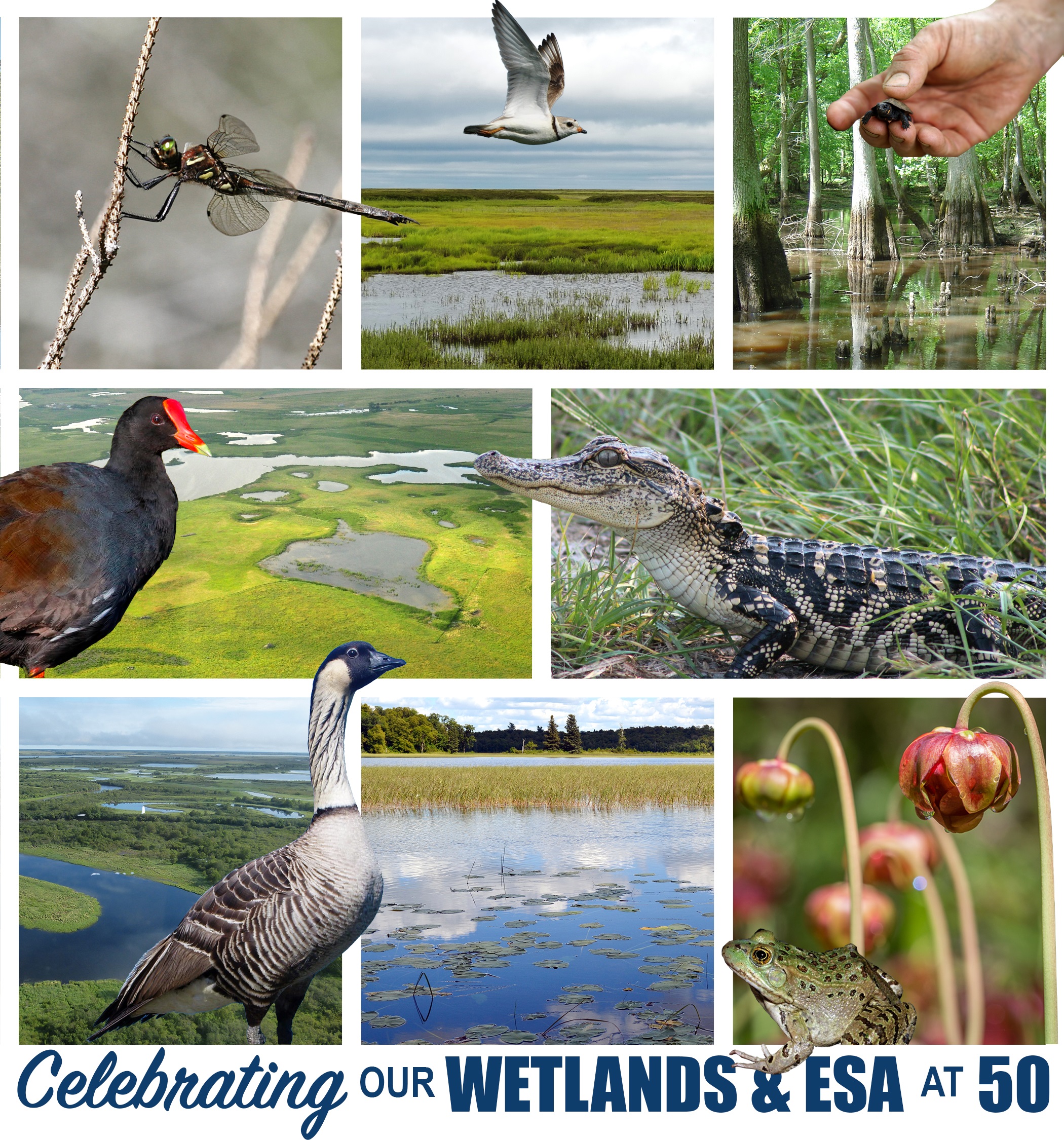
Held Wednesday, May 17, 2023 - 3:00 p.m. - 4:30 p.m. EDT
MODERATOR
- Martha Balis-Larsen, U.S. Fish and Wildlife Service [PRESENTATION PDF]
PRESENTERS
- Elizabeth Holmes Gaar, NOAA [PRESENTATION PDF]
- Kara Moore-O'Leary, U.S. Fish and Wildlife Service [PRESENTATION PDF]
- Aimee Weldon, U.S. Fish and Wildlife Service Northeast Regional Office [PRESENTATION PDF]
ABSTRACT
In celebration of the 50th anniversary of the Endangered Species Act (ESA), NAWM and the U.S. Fish and Wildlife Service (USFWS) hosted a panel discussion on wetland-dependent threatened and endangered (T&E) species. Wetlands account for just 5.5% of the contiguous U.S., yet 50% of T&E species are wetland-dependent. Conserving and restoring wetland habitat therefore plays an outsized role in the success of ESA. The two primary federal agencies responsible for implementing ESA are the USFWS and NOAA. Staff from both agencies highlighted how ESA has saved specific fish, migratory bird and amphibian species from extinction and describe some of the barriers that remain.
BIOS
 Elizabeth Holmes is NOAA Fisheries’ West Coast Region Habitat Program Leader and also the Senior Policy Advisor for Protected Resources. In her 35 years with NOAA Fisheries, Ms. Gaar developed and led various components of regional and national habitat and Endangered Species Act (ESA) programs. She served as the first Chief of Endangered Species in the Pacific Northwest (NW) when petitions to list salmon and steelhead under the ESA first emerged and later served as Assistant Regional Administrator for Habitat Conservation, where she established NMFS NW Region’s ESA and Magnuson Stevens Act essential fish habitat regulatory programs. Ms. Gaar also served as NOAA’s NW Region Chief of Salmon Recovery, responsible for developing and implementing the Region’s ESA salmon recovery program. Prior to working for NOAA, Ms. Gaar was a District Fishery Biologist with the US Forest Service with tenures on both the Siuslaw and Mt. Hood National Forests. She earned her Bachelor’s of Fisheries Science degree from Oregon State University and her law degree from the Northwestern School of Law, Lewis and Clark College.
Elizabeth Holmes is NOAA Fisheries’ West Coast Region Habitat Program Leader and also the Senior Policy Advisor for Protected Resources. In her 35 years with NOAA Fisheries, Ms. Gaar developed and led various components of regional and national habitat and Endangered Species Act (ESA) programs. She served as the first Chief of Endangered Species in the Pacific Northwest (NW) when petitions to list salmon and steelhead under the ESA first emerged and later served as Assistant Regional Administrator for Habitat Conservation, where she established NMFS NW Region’s ESA and Magnuson Stevens Act essential fish habitat regulatory programs. Ms. Gaar also served as NOAA’s NW Region Chief of Salmon Recovery, responsible for developing and implementing the Region’s ESA salmon recovery program. Prior to working for NOAA, Ms. Gaar was a District Fishery Biologist with the US Forest Service with tenures on both the Siuslaw and Mt. Hood National Forests. She earned her Bachelor’s of Fisheries Science degree from Oregon State University and her law degree from the Northwestern School of Law, Lewis and Clark College.
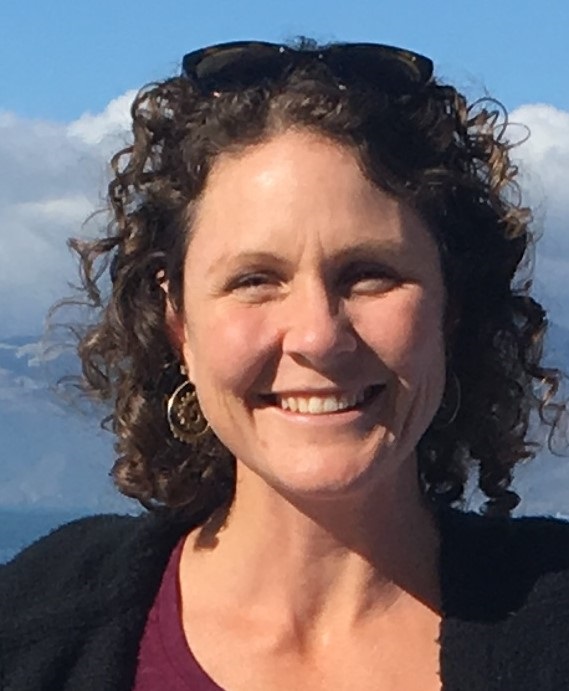
Kara Moore-O'Leary is an Ecologist for the National Wildlife Refuges in the Pacific Southwest Region 8 and the Zone Biologist for the Central Valley of California and the Klamath Basin. She has supported National Wildlife Refuges in design of survey protocols for threatened and endangered plants and has conducted research on T&E plant species reproduction, population dynamics, and range distributions. She received her bachelor’s in biology and her master's degree in Natural Resource Management from the from University of Michigan and her PhD in Ecology and Conservation Biology from the University of California, Davis. Before joining the Service, she conducted research in the Department of Evolution and Ecology at UC Davis on rare plant reproductive biology, reducing the ecological impacts of utility scale energy, and ecosystem restoration in arid ecosystems. She has been supporting Refuges in conservation planning, survey protocol development, and evidence-based approaches to conservation since she joined the US Fish and Wildlife Service in 2016.
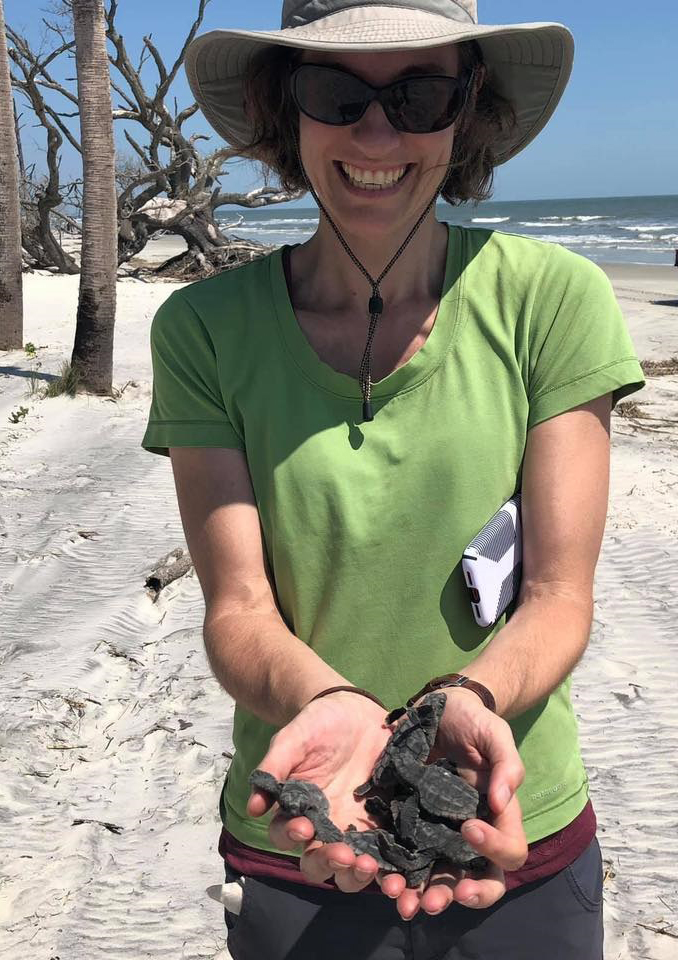 Aimee Weldon has been the Atlantic Coast Joint Venture Coordinator (ACJV) since 2016 based in Hadley, Massachusetts at the USFWS Northeast Regional Office. As Coordinator, Aimee is responsible for guiding the strategic vision of the Joint Venture, and to coordinate the many partnerships on priority species conservation. Prior to joining the ACJV, she directed the land protection and habitat restoration activities at Potomac Conservancy, a regional land trust and watershed organization dedicated to conserving and improving water quality in the Potomac River Basin. Aimee also held wildlife leadership positions at Defenders of Wildlife in Washington D.C., where she managed a national program to engage land trusts in biodiversity conservation, and at the National Audubon Society, where she coordinated the Virginia Important Bird Areas program. She is the primary author of ‘Conserving Habitat through the Federal Farm Bill – A Guide for Land Trusts and Landowners’, created to connect a wider network of practitioners to the many opportunities to leverage Farm Bill dollars for wildlife conservation. Aimee received her Master’s degree in Ecology from North Carolina State University and her Bachelor’s degree in Biology from the College of St. Benedict in Minnesota.
Aimee Weldon has been the Atlantic Coast Joint Venture Coordinator (ACJV) since 2016 based in Hadley, Massachusetts at the USFWS Northeast Regional Office. As Coordinator, Aimee is responsible for guiding the strategic vision of the Joint Venture, and to coordinate the many partnerships on priority species conservation. Prior to joining the ACJV, she directed the land protection and habitat restoration activities at Potomac Conservancy, a regional land trust and watershed organization dedicated to conserving and improving water quality in the Potomac River Basin. Aimee also held wildlife leadership positions at Defenders of Wildlife in Washington D.C., where she managed a national program to engage land trusts in biodiversity conservation, and at the National Audubon Society, where she coordinated the Virginia Important Bird Areas program. She is the primary author of ‘Conserving Habitat through the Federal Farm Bill – A Guide for Land Trusts and Landowners’, created to connect a wider network of practitioners to the many opportunities to leverage Farm Bill dollars for wildlife conservation. Aimee received her Master’s degree in Ecology from North Carolina State University and her Bachelor’s degree in Biology from the College of St. Benedict in Minnesota.
Please click only once on each video recording to view in this window.

MARSH Webinar 2: Communication and Branding
Held Wednesday, April 19, 2023 - 3:00 p.m.-4:30 p.m. EST
INTRODUCTION
- Ian Grosfelt, National Association of Wetland Managers
Please click only once on each video recording to view in this window.

Development of Rapid Streamflow Duration Assessment Methods for Nationwide Coverage
Held Thursday, April 13, 2023 - 3:00 p.m. - 4:30 p.m. EDT
INTRODUCTION
• Portia Osborne, National Association of Wetland Managers [PRESENTATION PDF]
PRESENTERS [PRESENTATION PDF]
- Brian Topping, U.S. Environmental Protection Agency, Office of Wetlands, Oceans and Watersheds
- Tracie Nadeau, U.S. Environmental Protection Agency, Region 10
ABSTRACT
Practitioners and regulated entities need rapid, reach-scale methods to classify streamflow duration to implement and comply with many federal, state, and local programs. The U.S. Environmental Protection Agency, working cooperatively with the U.S. Army Corps of Engineers, is developing regional streamflow duration assessment methods (SDAMs) for nationwide coverage. These SDAMs use hydrological, geomorphological, and biological indicators, observable in a single site visit to classify reaches as perennial, intermittent, or ephemeral (https://www.epa.gov/streamflow-duration-assessment). We presented five regional beta methods that resulted from multi-year studies conducted nationwide and included the evaluation of 141 candidate indicators expected to control or respond to streamflow duration at reaches of known streamflow duration class. To maximize classification accuracy, each regional SDAM relies on a different suite of indicators resulting from machine learning applied to regional datasets. Beta SDAMs will be re-evaluated considering user comments and additional data to produce final methods in 2023-24. We described the SDAM development process, including data analysis and management, highlight similarities and differences between the regional SDAMs, invited user comment on the beta methods, and discussed opportunities for more refined regionalization.
BIOS
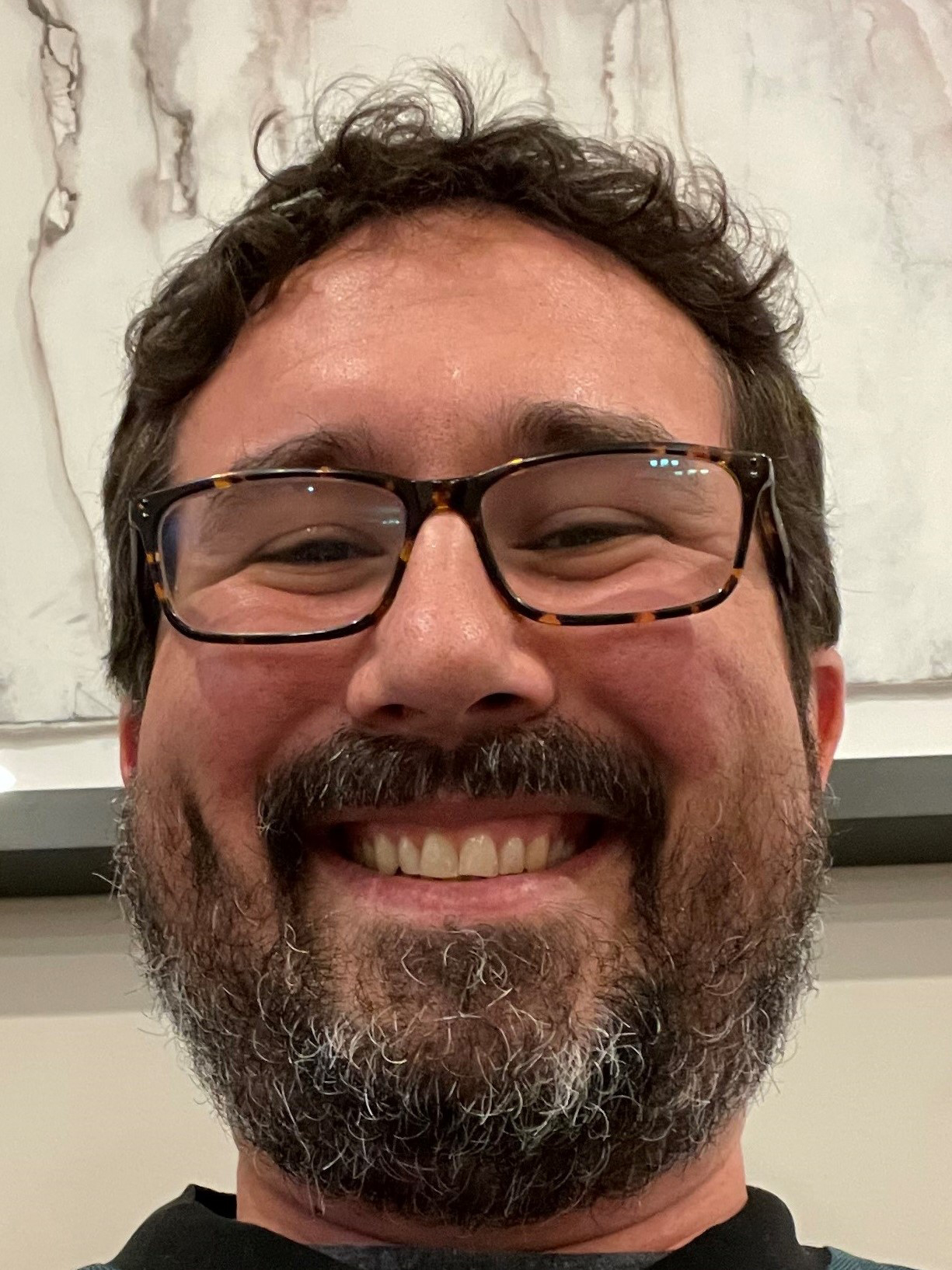 Brian Topping has worked at the U.S. Environmental Protection Agency since 2004 primarily in the Clean Water Act Section 404 regulatory program for the discharge of dredge and fill material in waters of the United States. Brian began working on streamflow duration assessment method development in 2007 in Oregon and currently leads the project delivery team for the development of rapid field-based streamflow duration assessment methods at EPA. He also works on stream mitigation assessment methods, program tracking and reporting, program training, and compensatory mitigation.
Brian Topping has worked at the U.S. Environmental Protection Agency since 2004 primarily in the Clean Water Act Section 404 regulatory program for the discharge of dredge and fill material in waters of the United States. Brian began working on streamflow duration assessment method development in 2007 in Oregon and currently leads the project delivery team for the development of rapid field-based streamflow duration assessment methods at EPA. He also works on stream mitigation assessment methods, program tracking and reporting, program training, and compensatory mitigation.
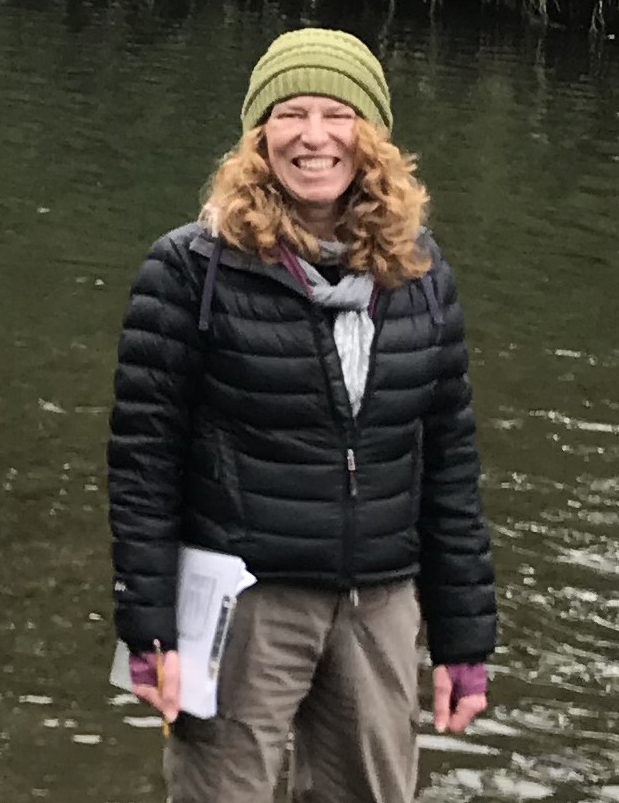 Tracie Nadeau is an Environmental Scientist with the U.S. Environmental Protection Agency, Region 10 (Pacific Northwest), Tracie Nadeau is currently on detail to EPA Headquarters’ Office of Wetlands, Oceans and Watersheds (OWOW) as a core member of the small team developing Streamflow Duration Assessment Methods (SDAMs) for nationwide coverage. She began working on streamflow duration assessment method development in 2007 when she led the development of an SDAM for the Pacific Northwest. Tracie is a broadly trained aquatic ecologist with over 20 years of experience working at the science-policy interface, synthesizing and communicating state of the science on aquatic resource issues, implementing programs, and developing and coordinating applied research projects. In her Region 10 Oregon Operations home office, she works on stream, wetland, watershed, and mitigation issues, including working with state and tribal partners to build program capacity and develop science-based tools supporting program implementation.
Tracie Nadeau is an Environmental Scientist with the U.S. Environmental Protection Agency, Region 10 (Pacific Northwest), Tracie Nadeau is currently on detail to EPA Headquarters’ Office of Wetlands, Oceans and Watersheds (OWOW) as a core member of the small team developing Streamflow Duration Assessment Methods (SDAMs) for nationwide coverage. She began working on streamflow duration assessment method development in 2007 when she led the development of an SDAM for the Pacific Northwest. Tracie is a broadly trained aquatic ecologist with over 20 years of experience working at the science-policy interface, synthesizing and communicating state of the science on aquatic resource issues, implementing programs, and developing and coordinating applied research projects. In her Region 10 Oregon Operations home office, she works on stream, wetland, watershed, and mitigation issues, including working with state and tribal partners to build program capacity and develop science-based tools supporting program implementation.
Please click only once on each video recording to view in this window.
Introduction to the new national manual on the Ordinary High Water Mark
Held Wednesday, March 29, 2023 - 2:00 p.m. - 3:00 p.m. EDT
INTRODUCTION
- Portia Osborne, National Association of Wetland Managers [PRESENTATION PDF]
PRESENTER
- Gabrielle C. L. David, Ph.D., Research Physical Scientist, U.S. Army Corps of Engineers Research Development Center [PRESENTATION PDF]
ABSTRACT
Ordinary High Water Mark (OHWM) delineation has long been a part of identifying aquatic resources that may be subject to federal jurisdiction under Section 404 of the Clean Water Act and Sections 9 and 10 of the Rivers and Harbors Act of 1899. Despite the challenges found in OHWM delineation, because of the complexity and dynamic nature of inland waterways, a national manual providing guidance on OHWM identification and delineation has never been released. The National Technical Committee for OHWM, comprised of experts from Federal agencies and academia, developed and released the interim draft of the National OHWM Field Delineation Manual for Rivers and Streams. The manual provides a scientifically supported, weight-of-evidence framework to support efficient OHWM identification and delineation that are consistent, repeatable and defensible. Use of the National OHWM Manual will result in timely and more predictable identification and delineation of the OHWM across the Nation.
BIO
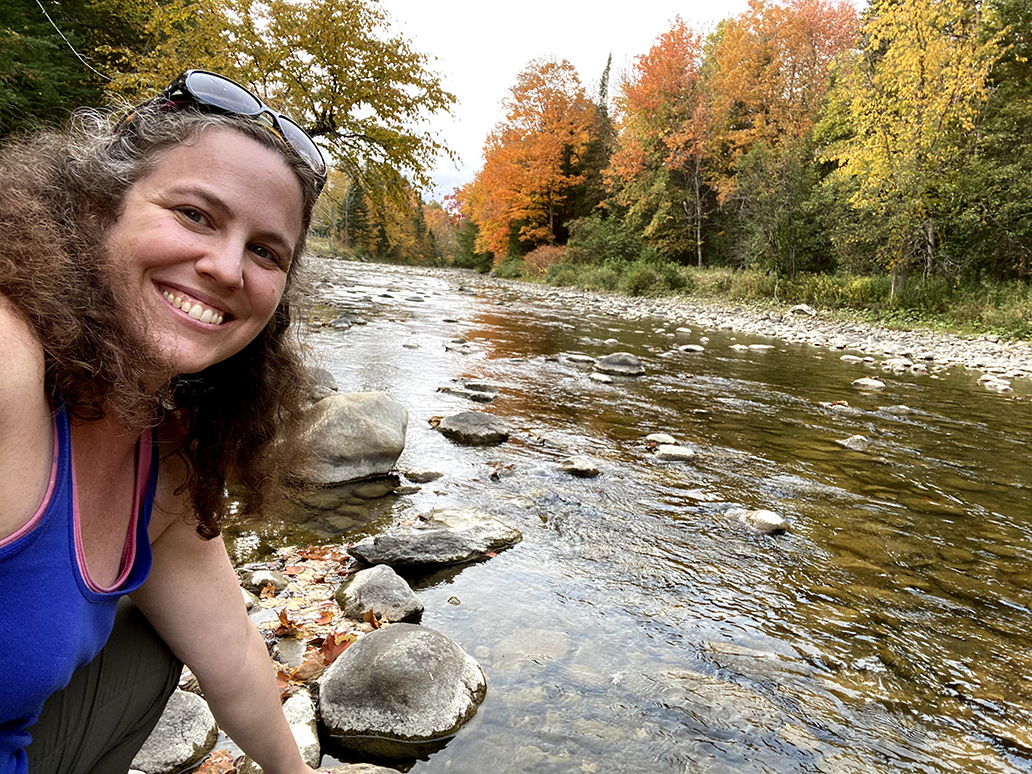 Gabrielle David is a research physical scientist specializing in fluvial geomorphology in the Remote Sensing/GIS Center of Expertise at the U.S. Army Engineer Research and Development Center (ERDC) Cold Regions Research and Engineering Laboratory (CRREL). Dr. David leads applied research projects on stream systems in support of the US Army Corps of Engineers (USACE) Regulatory Program through the ERDC-led Wetland Regulatory Assistance Program (WRAP). WRAP accelerates and enhances USACE Regulatory decisions by developing rapid decision support tools and integrating sound science and technical concepts into the USACE decision-making process. Dr. David supports WRAP and Regulatory through development of innovative tools and technical resources, and by providing scientific reasoning for regulatory decisions. In particular, Dr. David chairs the National Technical Committee for OHWM and leads projects on improving methods and tools used for assessing streams. Prior to her time at ERDC-CRREL, Dr. David was a visiting assistant professor at Boston College and Bowdoin College. She has taught courses in river restoration, environmental geology, geomorphology, water resources, ecology, and environmental studies. Currently, she teaches regional courses on field identification of the OHWM and is part of a team developing a course on stream restoration for regulators. Dr. David received her BS in Environmental Geology from The College of William and Mary and her MS and PhD in Geosciences from Colorado State University.
Gabrielle David is a research physical scientist specializing in fluvial geomorphology in the Remote Sensing/GIS Center of Expertise at the U.S. Army Engineer Research and Development Center (ERDC) Cold Regions Research and Engineering Laboratory (CRREL). Dr. David leads applied research projects on stream systems in support of the US Army Corps of Engineers (USACE) Regulatory Program through the ERDC-led Wetland Regulatory Assistance Program (WRAP). WRAP accelerates and enhances USACE Regulatory decisions by developing rapid decision support tools and integrating sound science and technical concepts into the USACE decision-making process. Dr. David supports WRAP and Regulatory through development of innovative tools and technical resources, and by providing scientific reasoning for regulatory decisions. In particular, Dr. David chairs the National Technical Committee for OHWM and leads projects on improving methods and tools used for assessing streams. Prior to her time at ERDC-CRREL, Dr. David was a visiting assistant professor at Boston College and Bowdoin College. She has taught courses in river restoration, environmental geology, geomorphology, water resources, ecology, and environmental studies. Currently, she teaches regional courses on field identification of the OHWM and is part of a team developing a course on stream restoration for regulators. Dr. David received her BS in Environmental Geology from The College of William and Mary and her MS and PhD in Geosciences from Colorado State University.
Please click only once on each video recording to view in this window.
![]()
MARSH Mentorship Introductory Webinar
Held Tuesday, February 14, 2023 - 2:00 p.m.-3:30 p.m. EST
INTRODUCTION
- Ian Grosfelt, National Association of Wetland Managers
Please click only once on each video recording to view in this window.
![]()
Recommendations for Reducing Wetland Loss in Coastal Watersheds of the United States
Tuesday, January 31, 2023 - 3:00 p.m.-4:30 p.m. EST
INTRODUCTION
- Ian Grosfelt, National Association of Wetland Managers [PRESENTATIONS PDF]
PRESENTERS
- Amanda Santoni, U.S. Environmental Protection Agency
- Jonathan Phinney, National Wetland Inventory
- Marla Stelk, National Association of Wetland Managers
ABSTRACT
The Interagency Coastal Wetlands Workgroup (ICWWG) recently released the Recommendations for Reducing Wetland Loss in Coastal Watersheds of the United States. This report presents voluntary recommendations that aim to reduce and reverse the loss of wetlands in coastal watersheds and are intended apply to program managers, non-governmental organizations, and government staff (federal, state, tribal, local, and regional) involved in coastal wetland and watershed management. The intent of the report is to help forge cooperation and build capacity to reduce coastal wetland losses nationwide. This webinar provided an introduction to and background on the Recommendations report and share efforts by agencies and partners to implement specific recommendations. In addition, recommendations that may be best addressed by state, tribal, or local governments was highlighted.
BIOS
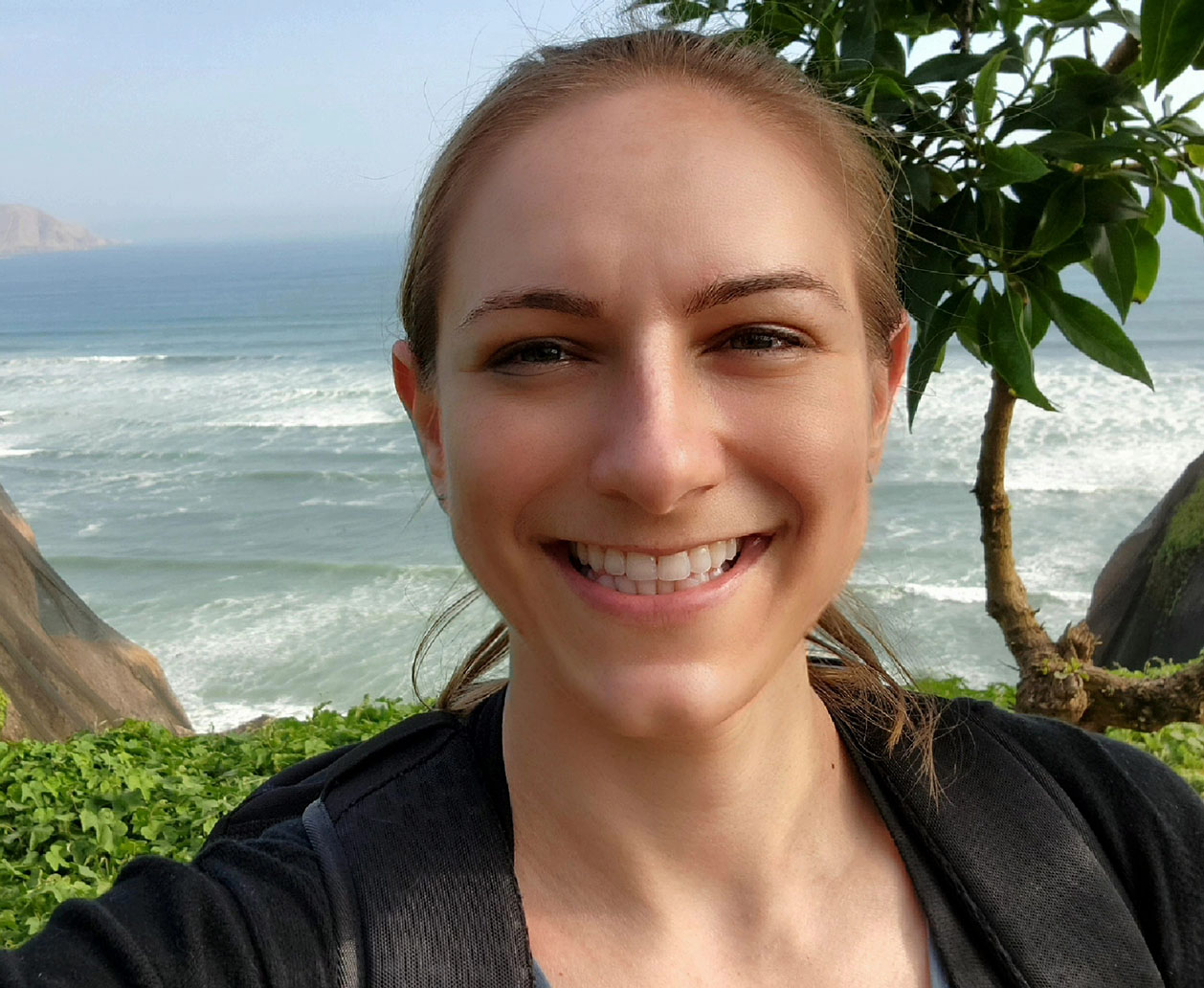 Amanda Santoni is an Ecologist at the U.S. Environmental Protection Agency. Specifically, she works in the Ocean and Coastal Management Branch on the Coastal Wetlands Initiative. She leads the Interagency Coastal Wetlands Workgroup (ICWWG) which helps to address coastal wetland loss, management, and restoration by bringing together seven federal agencies with programs and authorities that protect and manage coastal wetlands.
Amanda Santoni is an Ecologist at the U.S. Environmental Protection Agency. Specifically, she works in the Ocean and Coastal Management Branch on the Coastal Wetlands Initiative. She leads the Interagency Coastal Wetlands Workgroup (ICWWG) which helps to address coastal wetland loss, management, and restoration by bringing together seven federal agencies with programs and authorities that protect and manage coastal wetlands.
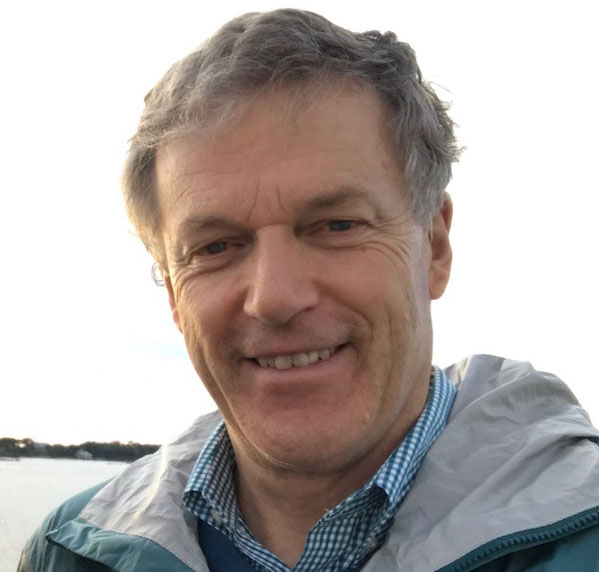 Jonathan Phinney started his career with the U.S. Fish and Wildlife Service (Service) in 2012. Presently, he is the Branch Chief for the National Wetlands Inventory Program where he oversees 12 staff located in five regional office and headquarters. He has also managed the Coastal Barrier Resources Program and the Analytical Control Facility. He spent the previous ten years at NOAA where he held several technical and management roles in NOAA Fisheries and NOAA’s Ocean and Atmospheric Research Program. He also logged four years in the nonprofit conservation world of Washington, D.C. after completing his graduate studies and a postdoc. Originally from the great state of Connecticut, he spent 10 years in California, but considers himself a (Northern) Virginian where he and his family enjoy outdoor hiking and biking and viewing the wetlands along the Potomac River and tributaries.
Jonathan Phinney started his career with the U.S. Fish and Wildlife Service (Service) in 2012. Presently, he is the Branch Chief for the National Wetlands Inventory Program where he oversees 12 staff located in five regional office and headquarters. He has also managed the Coastal Barrier Resources Program and the Analytical Control Facility. He spent the previous ten years at NOAA where he held several technical and management roles in NOAA Fisheries and NOAA’s Ocean and Atmospheric Research Program. He also logged four years in the nonprofit conservation world of Washington, D.C. after completing his graduate studies and a postdoc. Originally from the great state of Connecticut, he spent 10 years in California, but considers himself a (Northern) Virginian where he and his family enjoy outdoor hiking and biking and viewing the wetlands along the Potomac River and tributaries.
 Marla Stelk is the Executive Director at the National Association of Wetland Managers (NAWM) where she has worked on wetland policy and management issues since 2013. Marla has over 25 years of experience working on wetland, water, and wildlife issues, climate change, environmental policy and research, land use planning, communications and organizational leadership. Marla has led research at NAWM on topics such as ecosystem service valuation for wetland restoration, the role of wetlands in floodplain and natural hazard management, wetlands and watershed health, wetland mapping and communications. Prior to coming to NAWM, Marla worked for a variety of environmental and social nonprofit organizations helping to build organizational capacity, manage projects and improve internal processes. Marla earned her MA in Community Planning and Development with a focus on Land Use and the Environment at the University of Southern Maine’s Muskie School of Public Service and her BA in Environmental Issues from Colorado College.
Marla Stelk is the Executive Director at the National Association of Wetland Managers (NAWM) where she has worked on wetland policy and management issues since 2013. Marla has over 25 years of experience working on wetland, water, and wildlife issues, climate change, environmental policy and research, land use planning, communications and organizational leadership. Marla has led research at NAWM on topics such as ecosystem service valuation for wetland restoration, the role of wetlands in floodplain and natural hazard management, wetlands and watershed health, wetland mapping and communications. Prior to coming to NAWM, Marla worked for a variety of environmental and social nonprofit organizations helping to build organizational capacity, manage projects and improve internal processes. Marla earned her MA in Community Planning and Development with a focus on Land Use and the Environment at the University of Southern Maine’s Muskie School of Public Service and her BA in Environmental Issues from Colorado College.
Please click only once on each video recording to view in this window.
![]()
Advancing the Integration of Clean Water Act Programs with Natural Hazard Mitigation Planning & Implementation
Held Tuesday, January 17, 2023 - 3:00 p.m.-4:00 p.m. EST
This was a 60-minute informational webinar regarding a new project designed to aid states, local communities, and tribes in integrating their Clean Water Act programs with their natural hazard mitigation programs. This project is being implemented by the National Association of Wetland Managers and the Association of State Floodplain Managers in partnership with the U.S. Environmental Protection Agency (EPA). Beginning in 2023 and over the course of five years, we will host one annual in-person training workshop in five pre-determined regions. This introductory webinar included a background discussion of water and natural hazard mitigation, an overview of current EPA resources to get started, and an outline of the goals and processes of this project in addressing deeper needs. There was 30 minutes for Q&A and information on the nominating process for those interested in attending a workshop.
INTRODUCTION
- Ian Grosfelt, National Association of Wetland Managers [PRESENTATIONS PDF]
PRESENTERS
- Marla Stelk, National Association of Wetland Managers
- Ellie Flaherty, U.S. Environmental Protection Agency
- Jenna Moran, Association of State Floodplain Managers
WEBINAR RESOURCES
- Project Summary and Nominating Process
- EPA Nature-Based BMPs with Co-Benefits for Water Quality and Hazard Mitigation
- ASFPM CRS for Community Resilience Green Guide
- NAWM Healthy Wetlands Healthy Watersheds White Paper
- FEMA Mitigation Planning and the Community Rating System: Key Topics Bulletin
BIOS
 Marla Stelk is the Executive Director at the National Association of Wetland Managers (NAWM) where she has worked on wetland policy and management issues since 2013. Marla has over 25 years of experience working on wetland, water, and wildlife issues, climate change, environmental policy and research, land use planning, communications and organizational leadership. Marla has led research at NAWM on topics such as ecosystem service valuation for wetland restoration, the role of wetlands in floodplain and natural hazard management, wetlands and watershed health, wetland mapping and communications. Prior to coming to NAWM, Marla worked for a variety of environmental and social nonprofit organizations helping to build organizational capacity, manage projects and improve internal processes. Marla earned her MA in Community Planning and Development with a focus on Land Use and the Environment at the University of Southern Maine’s Muskie School of Public Service and her BA in Environmental Issues from Colorado College.
Marla Stelk is the Executive Director at the National Association of Wetland Managers (NAWM) where she has worked on wetland policy and management issues since 2013. Marla has over 25 years of experience working on wetland, water, and wildlife issues, climate change, environmental policy and research, land use planning, communications and organizational leadership. Marla has led research at NAWM on topics such as ecosystem service valuation for wetland restoration, the role of wetlands in floodplain and natural hazard management, wetlands and watershed health, wetland mapping and communications. Prior to coming to NAWM, Marla worked for a variety of environmental and social nonprofit organizations helping to build organizational capacity, manage projects and improve internal processes. Marla earned her MA in Community Planning and Development with a focus on Land Use and the Environment at the University of Southern Maine’s Muskie School of Public Service and her BA in Environmental Issues from Colorado College.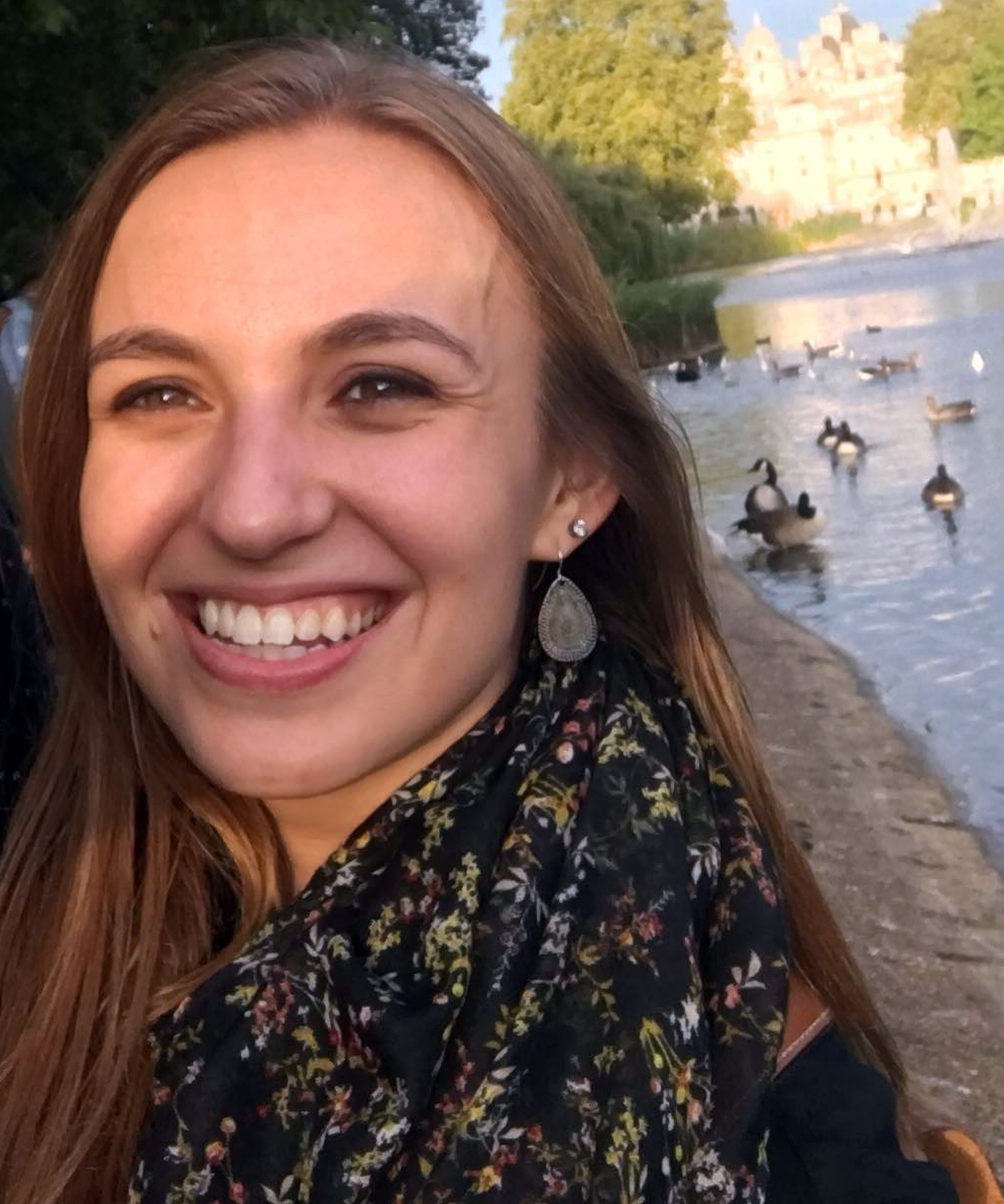 Ellie Flaherty is a Biologist in the Environmental Protection Agency’s Nonpoint Source (NPS) program. In this role she provides technical and programmatic support for the Clean Water Act Section 319 grant program and supports NPS program efforts to connect nature-based water quality practices with hazard mitigation and resilience planning. Ellie joined EPA shortly after receiving her Master of Science in Natural Resources and Environment from the University of Michigan in 2019.
Ellie Flaherty is a Biologist in the Environmental Protection Agency’s Nonpoint Source (NPS) program. In this role she provides technical and programmatic support for the Clean Water Act Section 319 grant program and supports NPS program efforts to connect nature-based water quality practices with hazard mitigation and resilience planning. Ellie joined EPA shortly after receiving her Master of Science in Natural Resources and Environment from the University of Michigan in 2019. 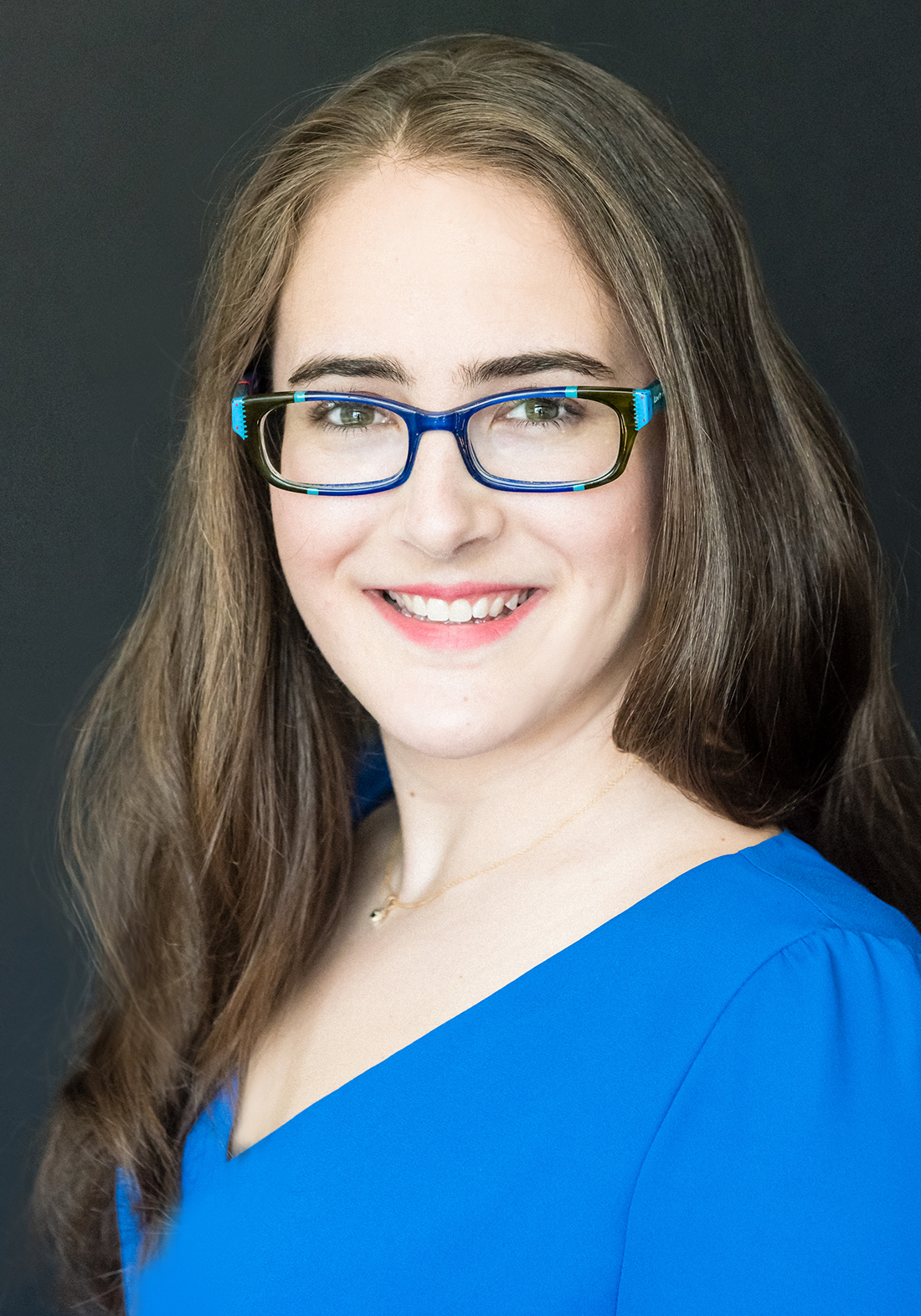 Jenna Moran joined the Flood Science Center as a Senior Project Manager in October 2020. Now, as the FSC Co-Director and Portfolio Manager, she oversees the administration of ASFPM's portfolio of grants while managing select projects within the portfolio. Before coming to ASFPM, Jenna was the Associate Program Director for Resilience at the National Association of Counties, where she handled grants and initiatives relating to resilience and community and economic development. Jenna holds a Master of Public Administration from The George Washington University and a Bachelor of Arts from the University of Notre Dame. Before transitioning into the world of resilience, she worked in arts and culture as a stage manager and a Design Program Specialist at the National Endowment for the Arts.
Jenna Moran joined the Flood Science Center as a Senior Project Manager in October 2020. Now, as the FSC Co-Director and Portfolio Manager, she oversees the administration of ASFPM's portfolio of grants while managing select projects within the portfolio. Before coming to ASFPM, Jenna was the Associate Program Director for Resilience at the National Association of Counties, where she handled grants and initiatives relating to resilience and community and economic development. Jenna holds a Master of Public Administration from The George Washington University and a Bachelor of Arts from the University of Notre Dame. Before transitioning into the world of resilience, she worked in arts and culture as a stage manager and a Design Program Specialist at the National Endowment for the Arts.
Please click only once on each video recording to view in this window.
![]()
PDF List of Past Hot Topics Webinar Recordings Here
View Upcoming Hot Topics Webinars

